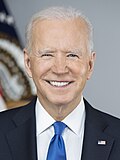User:44Nifty/sandbox
United States of America | ||
|---|---|---|
| Motto: Other traditional mottos:[2]
| ||
| Anthem: " | By race:
By Hispanic or Latino origin:
| |
| Religion (2021) Government | Federal presidential constitutional republic | |
| Joe Biden (D) | ||
| Kamala Harris (D) | ||
| Nancy Pelosi (D) | ||
| John Roberts | ||
| Legislature | Confederation | March 1, 1781 |
| September 3, 1783 | ||
| June 21, 1788 | ||
| August 21, 1959 | ||
Population | ||
• 2021 estimate | ||
• 2020 census | 331,449,281[e][14] (3rd) | |
• Density | 87/sq mi (33.6/km2) (185th) | |
| GDP (PPP) | 2022 estimate | |
• Total | ||
• Per capita | ||
| GDP (nominal) | 2022 estimate | |
• Total | ||
• Per capita | ||
| Gini (2020) | high | |
| HDI (2019) | very high (17th) | |
| Currency | U.S. dollar ($) (USD) | |
| Time zone | UTC−4 to −12, +10, +11 | |
• Summer (DST) | UTC−4 to −10[f] | |
| Date format | mm/dd/yyyy[g] | |
| Driving side | right[h] | |
| Calling code | +1 | |
| ISO 3166 code | US | |
The United States of America (U.S.A. or USA), commonly known as the United States (U.S. or US) or America, is a
Paleo-Indians
The United States is a
The United States is a highly
Etymology
The first known use of the name "America" dates to 1507, when it appeared on a world map produced by the German cartographer Martin Waldseemüller in the French city of Saint-Dié-des-Vosges. On his map, the name is shown in large letters on what would now be considered South America, honoring Amerigo Vespucci. The Italian explorer was the first to postulate that the West Indies did not represent Asia's eastern limit but were part of a previously unknown landmass.[26][27] In 1538, the Flemish cartographer Gerardus Mercator used the name "America" to the entire Western Hemisphere.[28]
The first documentary evidence of the phrase "United States of America" dates from a January 2, 1776 letter written by Stephen Moylan to Joseph Reed, George Washington's aide-de-camp. Moylan expressed his wish to go "with full and ample powers from the United States of America to Spain" to seek assistance in the revolutionary war effort.[29][30][31] The first known publication of the phrase "United States of America" was in an anonymous essay in The Virginia Gazette newspaper in Williamsburg, on April 6, 1776.[32]
The second draft of the Articles of Confederation and Perpetual Union, prepared by John Dickinson and completed no later than June 17, 1776, declared "The name of this Confederation shall be the 'United States of America'."[33] The final version of the Articles, sent to the states for ratification in late 1777, stated that "The Stile of this Confederacy shall be 'The United States of America'."[34] In June 1776, Thomas Jefferson wrote the phrase "UNITED STATES OF AMERICA" in all capitalized letters in the headline of his "original Rough draught" of the Declaration of Independence.[33] This draft of the document did not surface until June 21, 1776, and it is unclear whether it was written before or after Dickinson used the term in his June 17 draft of the Articles of Confederation.[33]
The phrase "United States" was originally plural in American usage. It described a collection of states—e.g., "the United States are..." The singular form became popular after the end of the Civil War and is now standard usage. A citizen of the United States is called an "American". "United States", "American", and "U.S." refer to the country adjectivally ("American values", "U.S. forces"). In English, the word "American" rarely refers to topics or subjects not directly connected with the United States.[35]
History
Indigenous peoples and pre-Columbian history
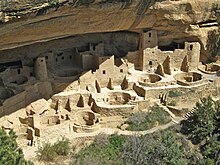
It is generally accepted that the
Over time, indigenous cultures in North America grew increasingly complex, and some, such as the pre-Columbian
Estimating the native population of North America during European contact is difficult.
European settlements
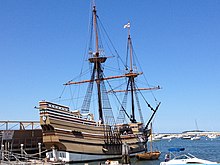
Claims of very early colonization of
Successful
In the early days of colonization, many European settlers were subject to food shortages, disease, and attacks from Native Americans. Native Americans were also often fighting neighboring tribes and European settlers. In many cases, however, the natives and settlers came to depend on each other. Settlers traded for food and animal pelts; natives for guns, tools and other European goods.[62] Natives taught many settlers to cultivate corn, beans, and other foodstuffs. European missionaries and others felt it was important to "civilize" the Native Americans and urged them to adopt European agricultural practices and lifestyles.[63][64] However, with the increased European colonization of North America, Native Americans were displaced and often killed during conflicts.[65]
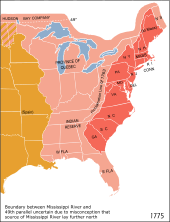
European settlers also began
The Thirteen Colonies[k] that would become the United States of America were administered by the British as overseas dependencies.[72] All nonetheless had local governments with elections open to most free men.[73] With very high birth rates, low death rates, and steady settlement, the colonial population grew rapidly, eclipsing Native American populations.[74] The Christian revivalist movement of the 1730s and 1740s known as the Great Awakening fueled interest both in religion and in religious liberty.[75]
During the Seven Years' War (1756–1763), known in the U.S. as the French and Indian War, British forces captured Canada from the French. With the creation of the Province of Quebec, Canada's francophone population would remain isolated from the English-speaking colonial dependencies of Nova Scotia, Newfoundland and the Thirteen Colonies. Excluding the Native Americans who lived there, the Thirteen Colonies had a population of over 2.1 million in 1770, about a third that of Britain. Despite continuing new arrivals, the rate of natural increase was such that by the 1770s only a small minority of Americans had been born overseas.[76] The colonies' distance from Britain had allowed the development of self-government, but their unprecedented success motivated British monarchs to periodically seek to reassert royal authority.[77]
Independence and expansion
The
In 1774, the First Continental Congress passed the Continental Association, which mandated a colony-wide boycott of British goods. The Second Continental Congress, an assembly representing the United Colonies, unanimously adopted the Declaration of Independence on July 4, 1776 (annually celebrated as Independence Day).[79] In 1781, the Articles of Confederation and Perpetual Union established a decentralized government that operated until 1789.[79]
After its defeat at the

Although the federal government outlawed American participation in the Atlantic slave trade in 1807, after 1820, cultivation of the highly profitable cotton crop exploded in the Deep South, and along with it, the slave population.[82][83][84] The Second Great Awakening, especially in the period 1800–1840, converted millions to evangelical Protestantism. In the North, it energized multiple social reform movements, including abolitionism;[85] in the South, Methodists and Baptists proselytized among slave populations.[86]
Beginning in the late 18th century, American settlers began to expand westward,[87] prompting a long series of American Indian Wars.[88] The 1803 Louisiana Purchase almost doubled the nation's area,[89] Spain ceded Florida and other Gulf Coast territory in 1819,[90] the Republic of Texas was annexed in 1845 during a period of expansionism,[91] and the 1846 Oregon Treaty with Britain led to U.S. control of the present-day American Northwest.[92] Victory in the Mexican–American War resulted in the 1848 Mexican Cession of California and much of the present-day American Southwest, making the U.S. span the continent.[87][93]
The
Civil War and Reconstruction era

Irreconcilable sectional conflict regarding
The Union initially simply fought to keep the country united. Nevertheless, as casualties mounted after 1863 and Lincoln delivered his Emancipation Proclamation, the main purpose of the war from the Union's viewpoint became the abolition of slavery. Indeed, when the Union ultimately won the war in April 1865, each of the states in the defeated South was required to ratify the Thirteenth Amendment, which prohibited slavery except as penal labor. Two other amendments were also ratified, ensuring citizenship and voting rights for blacks.[citation needed]
Southern white Democrats, calling themselves "
Further immigration, expansion, and industrialization
In the North, urbanization and an unprecedented
The United States fought Indian Wars west of the Mississippi River from 1810 to at least 1890.
World War I, Great Depression, and World War II

The United States remained neutral from the outbreak of
In 1920, the women's rights movement won passage of a constitutional amendment granting women's suffrage.[117] The 1920s and 1930s saw the rise of radio for mass communication and the invention of early television.[118] The prosperity of the Roaring Twenties ended with the Wall Street Crash of 1929 and the onset of the Great Depression. The Empire State Building was the world’s tallest skyscraper when it opened in 1931, during the Depression era. After his election as president in 1932, Franklin D. Roosevelt responded with the New Deal.[119] The Great Migration of millions of African Americans out of the American South began before World War I and extended through the 1960s;[120] whereas the Dust Bowl of the mid-1930s impoverished many farming communities and spurred a new wave of western migration.[121]

At first
The United States played a leading role in the
Cold War and late 20th century
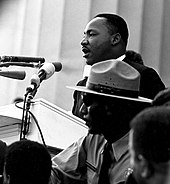
After World War II, the United States financed and implemented the Marshall Plan to help rebuild western Europe; disbursements paid between 1948 and 1952 would total $13 billion ($115 billion in 2021).[134] Also at this time, geopolitical tensions between the United States and Soviet Union led to the Cold War, driven by an ideological divide between capitalism and communism.[135] They dominated the military affairs of Europe, with the U.S. and its NATO allies on one side and the Soviet Union and its Warsaw Pact allies on the other.[136] The U.S. often opposed Third World movements that it viewed as Soviet-sponsored, sometimes pursuing direct action for regime change against left-wing governments.[137] American troops fought the communist forces in the Korean War of 1950–1953,[138] and the U.S. became increasingly involved in the Vietnam War (1955–1975), introducing combat forces in 1965.[139] Their competition to achieve superior spaceflight capability led to the Space Race, which culminated in the U.S. becoming the first nation to land people on the Moon in 1969.[138] While both countries engaged in proxy wars and developed powerful nuclear weapons, they avoided direct military conflict.[136]
At home, the U.S. had experienced
The growing
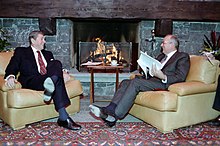
The 1970s and early 1980s saw the onset of
Due to the dot-com boom, stable monetary policy, and reduced social welfare spending, the 1990s saw the longest economic expansion in modern U.S. history.[159] Fearing the spread of instability from the Iraqi invasion of Kuwait, in August 1991, President George H. W. Bush launched and led the Gulf War against Iraq, expelling Iraqi forces and restoring the Kuwaiti monarchy.[160] Beginning in 1994, the U.S. signed the North American Free Trade Agreement (NAFTA), causing trade among the U.S., Canada, and Mexico to soar.[161]
21st century

On
Geography

The 48 contiguous states and the District of Columbia occupy a combined area of 3,119,885 square miles (8,080,470 km2). Of this area, 2,959,064 square miles (7,663,940 km2) is contiguous land, composing 83.65% of total U.S. land area.[173][174] The rest is occupied by Hawaii, an archipelago in the central Pacific, and the five populated but unincorporated territories of Puerto Rico, American Samoa, Guam, the Northern Mariana Islands, and the U.S. Virgin Islands.[175] Measured by only land area, the United States is third in size behind Russia and China, and just ahead of Canada.[176]
The United States is the world's third- or fourth-largest nation by total area (land and water), ranking behind Russia and Canada and nearly equal to China. The ranking varies depending on how two territories disputed by China and India are counted, and how the total size of the United States is measured.[c][177]
The
The
Biodiversity
The U.S. is one of 17
There are 63 national parks and hundreds of other federally managed parks, forests, and wilderness areas, which are managed by the National Park Service.[190] Altogether, the government owns about 28% of the country's land area,[191] mostly in the western states.[192] Most of this land is protected, though some is leased for oil and gas drilling, mining, logging, or cattle ranching, and about .86% is used for military purposes.[193][194]
Climate
The United States, with its large size and geographic variety, includes most climate types. To the east of the 100th meridian, the climate ranges from humid continental in the north to humid subtropical in the south.[202] The Great Plains west of the 100th meridian are semi-arid. Many mountainous areas of the American West have an alpine climate. The climate is arid in the Great Basin, desert in the Southwest, Mediterranean in coastal California, and oceanic in coastal Oregon and Washington and southern Alaska. Most of Alaska is subarctic or polar. Hawaii and the southern tip of Florida are tropical, as well as its territories in the Caribbean and the Pacific.[203] States bordering the Gulf of Mexico are prone to hurricanes, and most of the world's tornadoes occur in the country, mainly in Tornado Alley areas in the Midwest and South.[204] Overall, the United States receives more high-impact extreme weather incidents than any other country in the world.[205]
Extreme weather has become more frequent in the U.S., with three times the number of reported
Government and politics
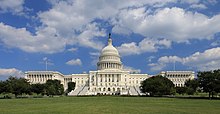
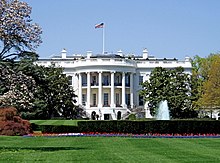
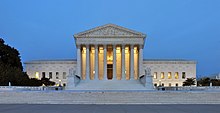
The United States is a federal republic of 50
The government is regulated by a system of checks and balances defined by the U.S. Constitution, which serves as the country's supreme legal document.[215] The Constitution establishes the structure and responsibilities of the federal government and its relationship with the individual states. The Constitution has been amended 27 times;[216] the first ten amendments (Bill of Rights) and the Fourteenth Amendment form the central basis of Americans' individual rights. All laws and governmental procedures are subject to judicial review, and any law can be voided if the courts determine that it violates the Constitution. The principle of judicial review, not explicitly mentioned in the Constitution, was established by the Supreme Court in Marbury v. Madison (1803).[217]
The federal government comprises three branches:
- Legislative: The bicameral Congress, made up of the Senate and the House of Representatives, makes federal law, declares war, approves treaties, has the power of the purse,[218] and has the power of impeachment, by which it can remove sitting members of the federal government.[219]
- Executive: The president is the commander-in-chief of the military, can veto legislative bills before they become law (subject to congressional override), and appoints the members of the Cabinet (subject to Senate approval) and other officers, who administer and enforce federal laws and policies.[220]
- Judicial: The Supreme Court and lower federal courts, whose judges are appointed by the president with Senate approval, interpret laws and overturn those they find unconstitutional.[221]
The House of Representatives has 435 voting members, each representing a congressional district for a two-year term. House seats are apportioned among the states by population. Each state then draws single-member districts to conform with the census apportionment. The District of Columbia and the five major U.S. territories each have one member of Congress—these members are not allowed to vote.[222]
The Senate has 100 members with each state having two senators, elected
Political divisions
Each of the 50 states holds jurisdiction over a geographic territory, where it shares
Citizenship is granted at birth in all states, the District of Columbia, and all major U.S. territories except American Samoa.[l][230][227] The United States observes limited tribal sovereignty of the American Indian nations, like states' sovereignty. American Indians are U.S. citizens and tribal lands are subject to the jurisdiction of the U.S. Congress and the federal courts. Like the states, tribes have some autonomy restrictions, such as not allowed to make war, engaging in their own foreign relations, print or issue independent currency.[231] Indian reservations are usually part of a state, with 12 reservations cross state boundaries.[232] Indian country jurisdiction over civil and criminal matters is shared by tribes, states, and the federal government.[citation needed]
Parties and elections
The United States has operated under a
In American
Democrat Joe Biden, the winner of the 2020 presidential election and former vice president, is serving as the 46th president of the United States. Leadership in the Senate includes Vice President Kamala Harris, President pro tempore Patrick Leahy, Majority Leader Chuck Schumer, and Minority Leader Mitch McConnell.[238] Leadership in the House includes Speaker of the House Nancy Pelosi, Majority Leader Steny Hoyer, and Minority Leader Kevin McCarthy.[239]
In the
Foreign relations

The United States has an established structure of foreign relations, and it had the world's second-largest diplomatic corps in 2019.
The United States has a "Special Relationship" with the United Kingdom[252] and strong ties with Canada,[253] Australia,[254] New Zealand,[255] the Philippines,[256] Japan,[257] South Korea,[258] Israel,[259] and several European Union countries (France, Italy, Germany, Spain, and Poland).[260] The U.S. works closely with its NATO allies on military and national security issues, and with nations in the Americas through the Organization of American States and the United States–Mexico–Canada Free Trade Agreement. In South America, Colombia is traditionally considered to be the closest ally of the United States.[261][262] The U.S. exercises full international defense authority and responsibility for Micronesia, the Marshall Islands and Palau through the Compact of Free Association.[263] In the 21st century, U.S. relations with Russia and China have deteriorated significantly.[264][265]
Military
The president is the
In 2019, all six branches of the U.S. Armed Forces reported 1.4 million personnel on active duty.
Today, American forces can be rapidly deployed by the Air Force's large fleet of
Government finance
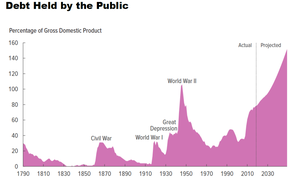
In 2010, taxes collected by federal, state and municipal governments amounted to 24.8% of GDP.[284] For 2018, the effective tax rate for the wealthiest 400 households was 23%, compared to 24.2% for the bottom half of U.S. households.[285] During fiscal year 2012, the federal government spent $3.54 trillion on a budget or cash basis. Major categories of fiscal year 2012 spending included: Medicare & Medicaid (23%), Social Security (22%), Defense Department (19%), non-defense discretionary (17%), other mandatory (13%) and interest (6%).[286]
In 2018, the United States had the largest external debt in the world.
Law enforcement and crime

There are about 18,000 U.S. police agencies from local to federal level in the United States.
As of 2020[update], the United States has a intentional homicide rate of 7 per 100,000 people.[295] A cross-sectional analysis of the World Health Organization Mortality Database from 2010 showed that United States homicide rates "were 7.0 times higher than in other high-income countries, driven by a gun homicide rate that was 25.2 times higher."[296]
The United States has the highest documented incarceration rate and largest prison population in the world.[297] In 2019, the total prison population for those sentenced to more than a year is 1,430,800, corresponding to a ratio of 419 per 100,000 residents and the lowest since 1995.[298] Some estimates place that number higher, such Prison Policy Initiative's 2.3 million.[299] Various states have attempted to reduce their prison populations via government policies and grassroots initiatives.[300]
Although most nations have abolished capital punishment,[301] it is sanctioned in the United States for certain federal and military crimes, and at the state level in 28 states, though three states have moratoriums on carrying out the penalty imposed by their governors.[302][303][304] Since 1977, there have been more than 1,500 executions,[305] giving the U.S. the sixth-highest number of executions in the world, following China, Iran, Saudi Arabia, Iraq, and Egypt.[306] However, the number is trended down nationally, with several states recently abolishing the penalty.[304][307]
Economy
According to the International Monetary Fund, the U.S. gross domestic product (GDP) of $22.7 trillion constitutes 24% of the gross world product at market exchange rates and over 16% of the gross world product at purchasing power parity (PPP).[309][15] From 1983 to 2008, U.S. real compounded annual GDP growth was 3.3%, compared to a 2.3% weighted average for the rest of the G7.[310] The country ranks fifth in the world in nominal GDP per capita[311] and seventh in GDP per capita at PPP.[15]
The
In 2009, the private sector was estimated to constitute 86.4% of the economy.[318] While its economy has reached a post-industrial level of development, the United States remains an industrial power.[319] In August 2010, the American labor force consisted of 154.1 million people (50%). With 21.2 million people, the public sector is the leading field of employment. The largest private employment sector is health care and social assistance, with 16.4 million people. It has a smaller welfare state and redistributes less income through government action than most other high-income countries.[320]
Science, technology, and energy
The United States has been a leader in technological
In 1876, Alexander Graham Bell was awarded the first U.S. patent for the telephone. Thomas Edison's research laboratory developed the phonograph, the first long-lasting light bulb, and the first viable movie camera.[327] The Wright brothers in 1903 made the first sustained and controlled heavier-than-air powered flight, and the automobile companies of Ransom E. Olds and Henry Ford popularized the assembly line in the early 20th century.[328] The rise of fascism and Nazism in the 1920s and 30s led many European scientists, such as Albert Einstein, Enrico Fermi, and John von Neumann, to immigrate to the United States.[329] During World War II, the Manhattan Project developed nuclear weapons, ushering in the Atomic Age. During the Cold War, competition for superior missile capability ushered in the Space Race between the U.S. and Soviet Union.[330][331] The invention of the transistor in the 1950s, a key component in almost all modern electronics, led to the development of microprocessors, software, personal computers and the Internet.[332]
As of 2019[update], the United States receives approximately 80% of its energy from fossil fuels.
Transportation

The United States'
Personal transportation is dominated by automobiles, which operate on a network of 4 million miles (6.4 million kilometers) of public roads.[341] The United States has the world's second-largest automobile market,[342] and has the highest vehicle ownership per capita in the world, with 816.4 vehicles per 1,000 Americans (2014).[343] In 2017, there were 255 million non-two wheel motor vehicles, or about 910 vehicles per 1,000 people.[344]
The
Income, wealth, and poverty
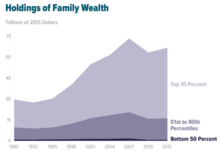
Accounting for 4.24% of the
For 2019, the
There were about 567,715 sheltered and unsheltered homeless persons in the U.S. in January 2019, with almost two-thirds staying in an emergency shelter or transitional housing program.[367] Attempts to combat homelessness include the Section 8 housing voucher program and implementation of the Housing First strategy across all levels of government.[368][369][370][371] In 2011, 16.7 million children lived in food-insecure households, about 35% more than 2007 levels, though only 845,000 U.S. children (1.1%) saw reduced food intake or disrupted eating patterns at some point during the year, and most cases were not chronic.[372] As of June 2018,[update] 40 million people, roughly 12.7% of the U.S. population, were living in poverty, including 13.3 million children. Of those impoverished, 18.5 million live in "deep poverty", family income below one-half of the federal government's poverty threshold.[373]
Demographics
Population
| Census | Pop. | Note | %± |
|---|---|---|---|
| 1790 | 3,929,214 | — | |
| 1800 | 5,308,483 | 35.1% | |
| 1810 | 7,239,881 | 36.4% | |
| 1820 | 9,638,453 | 33.1% | |
| 1830 | 12,866,020 | 33.5% | |
| 1840 | 17,069,453 | 32.7% | |
| 1850 | 23,191,876 | 35.9% | |
| 1860 | 31,443,321 | 35.6% | |
| 1870 | 38,558,371 | 22.6% | |
| 1880 | 50,189,209 | 30.2% | |
| 1890 | 62,979,766 | 25.5% | |
| 1900 | 76,212,168 | 21.0% | |
| 1910 | 92,228,496 | 21.0% | |
| 1920 | 106,021,537 | 15.0% | |
| 1930 | 123,202,624 | 16.2% | |
| 1940 | 132,164,569 | 7.3% | |
| 1950 | 151,325,798 | 14.5% | |
| 1960 | 179,323,175 | 18.5% | |
| 1970 | 203,211,926 | 13.3% | |
| 1980 | 226,545,805 | 11.5% | |
| 1990 | 248,709,873 | 9.8% | |
| 2000 | 281,421,906 | 13.2% | |
| 2010 | 308,745,538 | 9.7% | |
| 2020 | 331,449,281 | 7.4% | |
| 2021 (est.) | 331,893,745 | [13] | 0.1% |
| Note that the census numbers do not include Native Americans until 1860.[374] | |||
The
The United States has a diverse population; 37
In 2018, there were almost 90 million immigrants and
Language
English (specifically,
According to the American Community Survey, in 2010 some 229 million people (out of the total U.S. population of 308 million) spoke only English at home. More than 37 million spoke Spanish at home, making it the second most commonly used language in the United States. Other languages spoken at home by one million people or more include Chinese (2.8 million), Tagalog (1.6 million), Vietnamese (1.4 million), French (1.3 million), Korean (1.1 million), and German (1 million).[391]
The
Urbanization
About 82% of Americans live in
Rank
|
Name
|
Region | Municipal pop.
|
Rank
|
Name
|
Region | Pop. |
||
|---|---|---|---|---|---|---|---|---|---|
Los Angeles
|
1 | New York | Northeast | 19,498,249 | 11 | Boston | Northeast | 4,919,179 |  Chicago  Dallas–Fort Worth |
| 2 | Los Angeles |
West | 12,799,100 | 12 | Riverside–San Bernardino | West | 4,688,053 | ||
| 3 | Chicago | Midwest | 9,262,825 | 13 | San Francisco | West | 4,566,961 | ||
| 4 | Dallas–Fort Worth | South | 8,100,037 | 14 | Detroit | Midwest | 4,342,304 | ||
| 5 | Houston | South | 7,510,253 | 15 | Seattle | West | 4,044,837 | ||
| 6 | Atlanta |
South | 6,307,261 | 16 | Minneapolis–Saint Paul | Midwest | 3,712,020 | ||
| 7 | Washington, D.C. | South | 6,304,975 | 17 | Tampa–St. Petersburg | South | 3,342,963 | ||
| 8 | Philadelphia | Northeast | 6,246,160 | 18 | San Diego | West | 3,269,973 | ||
| 9 | Miami | South | 6,183,199 | 19 | Denver | West | 3,005,131 | ||
| 10 | Phoenix | West | 5,070,110 | 20 | Baltimore |
South | 2,834,316 | ||
Religion

The First Amendment of the U.S. Constitution guarantees the free exercise of religion and forbids Congress from passing laws respecting its establishment.[399]
The United States has the
In a 2014 survey, 70.6% of adults in the United States identified themselves as Christians,[403] and 5.9% claimed a non-Christian religion.[404] These include Judaism (1.9%), Islam (1.1%), Hinduism (0.7%), and Buddhism (0.7%).[404] The survey also reported that 22.8% of Americans described themselves as agnostic, atheist or simply having no religion.[405][406][407] Membership in a house of worship fell from 70% in 1999 to 47% in 2020, much of the decline related to the number of Americans expressing no religious preference. However, membership also fell among those who identified with a specific religious group.[408][409]
Health
is the largest medical complex in the world.The
In 2010,
The U.S. health care system far
Government-funded health care coverage for the poor (
Education

American
The United States has many private and public
Culture and society

The United States is home to a
Americans have traditionally been characterized by a strong
The
The arts and philosophy

In the 18th and early 19th centuries, American art and literature took most of its cues from Europe, contributing to Western culture. Writers such as Washington Irving, Nathaniel Hawthorne, Edgar Allan Poe, and Henry David Thoreau established a distinctive American literary voice by the middle of the 19th century. Mark Twain and poet Walt Whitman were major figures in the century's second half; Emily Dickinson, virtually unknown during her lifetime, is recognized as an essential American poet.[458] A work seen as capturing fundamental aspects of the national experience and character—such as Herman Melville's Moby-Dick (1851), Twain's The Adventures of Huckleberry Finn (1885), F. Scott Fitzgerald's The Great Gatsby (1925) and Harper Lee's To Kill a Mockingbird (1960)—may be dubbed the "Great American Novel."[459]
Thirteen U.S. citizens have won the Nobel Prize in Literature. William Faulkner, Ernest Hemingway and John Steinbeck are often named among the most influential writers of the 20th century.[460] Popular literary genres such as the Western and hardboiled crime fiction developed in the United States.[citation needed] The Beat Generation writers opened up new literary approaches, as have postmodernist authors such as John Barth, Thomas Pynchon, and Don DeLillo.[461]
The transcendentalists, led by Thoreau and Ralph Waldo Emerson, established the first major American philosophical movement. After the Civil War, Charles Sanders Peirce and then William James and John Dewey were leaders in the development of pragmatism. In the 20th century, the work of W. V. O. Quine and Richard Rorty, and later Noam Chomsky, brought analytic philosophy to the fore of American philosophical academia. John Rawls and Robert Nozick also led a revival of political philosophy.[462][463]
In the visual arts, the Hudson River School was a mid-19th-century movement in the tradition of European naturalism. The 1913 Armory Show in New York City, an exhibition of European modernist art, shocked the public and transformed the U.S. art scene.[464] Georgia O'Keeffe, Marsden Hartley, and others experimented with new, individualistic styles. Major artistic movements such as the abstract expressionism of Jackson Pollock and Willem de Kooning and the pop art of Andy Warhol and Roy Lichtenstein developed largely in the United States. The tide of modernism and then postmodernism has brought fame to American architects such as Frank Lloyd Wright, Philip Johnson, and Frank Gehry.[465] Americans have long been important in the modern artistic medium of photography, with major photographers including Alfred Stieglitz, Edward Steichen, Edward Weston, and Ansel Adams.[466]
Food

Early settlers were introduced by Native Americans to such indigenous, non-European foods as turkey, sweet potatoes, corn, squash, and maple syrup. They and later immigrants combined these with foods they had known, such as wheat flour,[468] beef, and milk to create a distinctive American cuisine.[469][470] Homegrown foods are part of a shared national menu on one of America's most popular holidays, Thanksgiving, when many Americans make or purchase traditional foods to celebrate the occasion.[471]
The American
Music

Among America's earliest composers was a man named William Billings who, born in Boston, composed patriotic hymns in the 1770s;[481] Billings was a part of the First New England School, who dominated American music during its earliest stages. Anthony Heinrich was the most prominent composer before the Civil War. From the mid- to late 1800s, John Philip Sousa of the late Romantic era composed numerous military songs—particularly marches—and is regarded as one of America's greatest composers.[482] By the late 19th century, the Second New England School (sometimes referred to specifically as the "Boston Six") became prominent representatives of the classical tradition, of whom John Knowles Paine was the leading figure.[citation needed]
The rhythmic and lyrical styles of African-American music have deeply influenced American music at large, distinguishing it from European and African traditions. Elements from folk idioms such as the blues and what is known as old-time music were adopted and transformed into popular genres with global audiences. Jazz was developed by innovators such as Louis Armstrong and Duke Ellington early in the 20th century. Country music developed in the 1920s, and rhythm and blues in the 1940s.[483]
Elvis Presley and Chuck Berry were among the mid-1950s pioneers of rock and roll. Rock bands such as Metallica, the Eagles, and Aerosmith are among the highest grossing in worldwide sales.[484][485][486] In the 1960s, Bob Dylan emerged from the folk revival to become one of America's most celebrated songwriters.[487] Mid-20th-century American pop stars such as Bing Crosby, Frank Sinatra,[488] and Elvis Presley became global celebrities,[483] as have artists of the late 20th century such as Michael Jackson, Whitney Houston, Prince, and Madonna.[489][490] Popular entertainers of the 21st century include Eminem, Britney Spears, Beyoncé, Bruno Mars, Lady Gaga, Christina Aguilera, Justin Timberlake, Taylor Swift and Ariana Grande.[citation needed]
Cinema and theater
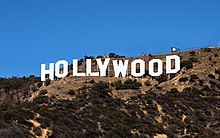
Director
Theater in the United States derives from the old European theatrical tradition and has been heavily influenced by the
Sports
While most major U.S. sports such as baseball and American football have evolved out of European practices, basketball, volleyball, skateboarding, and snowboarding are American inventions, some of which have become popular worldwide.[506] Lacrosse and surfing arose from Native American and Native Hawaiian activities that predate Western contact.[507] The market for professional sports in the United States is roughly $69 billion, roughly 50% larger than that of all of Europe, the Middle East, and Africa combined.[508]
American football is by several measures the most popular spectator sport in the United States;[509] the National Football League (NFL) has the highest average attendance of any sports league in the world, and the Super Bowl is watched by tens of millions globally.[510] Baseball has been regarded as the U.S. national sport since the late 19th century, with Major League Baseball being the top league. Basketball and ice hockey are the country's two popular professional team sports, with the top leagues being the National Basketball Association and the National Hockey League. The most-watched individual sports in the U.S. are golf and auto racing, particularly NASCAR and IndyCar.[511][512]
Eight
Mass media
The four major broadcasters in the U.S. are the
Well-known U.S. newspapers include
See also
- Index of United States–related articles
- Lists of U.S. state topics
- Outline of the United States
Notes
- official language of 32 states; English and Hawaiian are both official languages in Hawaii, and English and 20 indigenous languages are official in Alaska. Algonquian, Cherokee, and Sioux are among many other official languages in Native-controlled lands throughout the country. French is a de facto, but unofficial, language in Maine and Louisiana, while New Mexico law grants Spanish a special status. In five territories, English as well as one or more indigenous languages are official: Spanish in Puerto Rico, Samoan in American Samoa, and Chamorro in both Guam and the Northern Mariana Islands. Carolinian is also an official language in the Northern Mariana Islands.[4][5]
- ^ The historical and informal demonym Yankee has been applied to Americans, New Englanders, or northeasterners since the 18th century.
- ^ a b c The United States is the third-largest country by total area, after Russia and Canada, if its coastal and territorial water areas are included. If only its internal waters are included (bays, sounds, rivers, lakes, and the Great Lakes), the U.S. is the fourth-largest, after Russia, Canada, and China.
Coastal/territorial waters included: 3,796,742 sq mi (9,833,517 km2)[19]
Only internal waters included: 3,696,100 sq mi (9,572,900 km2)[20] - ^ a b The U.S. Census Bureau provides a continuously updated but unofficial population clock in addition to its decennial census and annual population estimates: [1]
- unincorporated islands because they are counted separately in U.S. censusstatistics.
- ^ See Time in the United States for details about laws governing time zones in the United States.
- ^ See Date and time notation in the United States.
- ^ A single jurisdiction, the U.S. Virgin Islands, uses left-hand traffic.
- ^ The five major territories are American Samoa, Guam, the Northern Mariana Islands, Puerto Rico, and the United States Virgin Islands. There are eleven smaller island areas without permanent populations: Baker Island, Howland Island, Jarvis Island, Johnston Atoll, Kingman Reef, Midway Atoll, and Palmyra Atoll. U.S. sovereignty over Bajo Nuevo Bank, Navassa Island, Serranilla Bank, and Wake Island is disputed.[18]
- U.S. Virgin Islands borders the British Virgin Islands.[21] Puerto Rico has a maritime border with the Dominican Republic.[22] American Samoa has a maritime border with the Cook Islands (see Cook Islands–United States Maritime Boundary Treaty).[23][24] American Samoa also has maritime borders with independent Samoa and Niue.[25]
- ^ New Hampshire, Massachusetts, Connecticut, Rhode Island, New York, New Jersey, Pennsylvania, Delaware, Maryland, Virginia, North Carolina, South Carolina, and Georgia
- ^ People born in American Samoa are non-citizen U.S. nationals, unless one of their parents is a U.S. citizen.[227] In 2019, a court ruled that American Samoans are U.S. citizens, but the litigation is onging.[228][229]
- U.S. Virgin Islands, American Samoa, and the Northern Mariana Islands) and minor island possessions.
- .
- ^ Also known less formally as Obamacare
References
- ^ 36 U.S.C. § 302
- U.S. Department of State, Bureau of Public Affairs. 2003. Retrieved February 12, 2020.
- ^ An Act To make The Star-Spangled Banner the national anthem of the United States of America (H.R. 14). 71st United States Congress. March 3, 1931.
- ^ Cobarrubias 1983, p. 195.
- ^ García 2011, p. 167.
- United States Census. Retrieved August 13, 2021.
- United States Census. Retrieved August 13, 2021.
- ^ "A Breakdown of 2020 Census Demographic Data". NPR. August 13, 2021.
- ^ "About Three-in-Ten U.S. Adults Are Now Religiously Unaffiliated". Measuring Religion in Pew Research Center's American Trends Panel. Pew Research Center. December 14, 2021. Retrieved December 21, 2021.
- ^ Compton's Pictured Encyclopedia and Fact-index: Ohio. 1963. p. 336.
- Census.gov. August 2010. Retrieved March 31, 2020.
reflect base feature updates made in the MAF/TIGER database through August, 2010.
- Organisation for Economic Co-operation and Development(OECD). 2015. Retrieved October 11, 2020.
- ^ a b Bureau, US Census. "New Vintage 2021 Population Estimates Available for the Nation, States and Puerto Rico". Census.gov.
- United States Census. Retrieved April 26, 2021. The 2020 census is as of April 1, 2020.
- ^ a b c d e f "World Economic Outlook Database, April 2022". IMF.org. International Monetary Fund. April 2022. Retrieved April 19, 2022.
- ^ Bureau, US Census. "Income and Poverty in the United States: 2020, Table A-3". Retrieved July 19, 2022.
- ^ "Human Development Report 2020: The Next Frontier: Human Development and the Anthropocene" (PDF). United Nations Development Programme. December 15, 2020. Retrieved December 15, 2020.
- ^ U.S. State Department, Common Core Document to U.N. Committee on Human Rights, December 30, 2011, Item 22, 27, 80. And U.S. General Accounting Office Report, U.S. Insular Areas: application of the U.S. Constitution Archived November 3, 2013, at the Wayback Machine, November 1997, pp. 1, 6, 39n. Both viewed April 6, 2016.
- CIA World Factbook. Retrieved June 10, 2016.
- ^ "United States". Encyclopædia Britannica. Archived from the original on December 19, 2013. Retrieved January 31, 2010.
- ^ "United States Virgin Islands". Encyclopædia Britannica (Online ed.). Archived from the original on April 29, 2020. Retrieved July 3, 2020.
- ^ "Puerto Rico". Encyclopædia Britannica (Online ed.). Archived from the original on July 2, 2020. Retrieved July 3, 2020.
- ISBN 9781579583750; OCLC 54061586
- ^ Charney, Jonathan I., David A. Colson, Robert W. Smith. (2005). International Maritime Boundaries, 5 vols. Hotei Publishing: Leiden.
- ^ "Pacific Maritime Boundaries". pacgeo.org. Archived from the original on July 31, 2020. Retrieved July 3, 2020.
- ^ Sider 2007, p. 226.
- ^ Szalay, Jessie (September 20, 2017). "Amerigo Vespucci: Facts, Biography & Naming of America". Live Science. Retrieved June 23, 2019.
- ^ Jonathan Cohen. "The Naming of America: Fragments We've Shored Against Ourselves". Archived from the original on October 6, 2018. Retrieved February 3, 2014.
- ^ DeLear, Byron (July 4, 2013) Who coined 'United States of America'? Mystery might have intriguing answer. "Historians have long tried to pinpoint exactly when the name 'United States of America' was first used and by whom ... This latest find comes in a letter that Stephen Moylan, Esq., wrote to Col. Joseph Reed from the Continental Army Headquarters in Cambridge, Mass., during the Siege of Boston. The two men lived with Washington in Cambridge, with Reed serving as Washington's favorite military secretary and Moylan fulfilling the role during Reed's absence." Christian Science Monitor (Boston, MA).
- ^ Touba, Mariam (November 5, 2014) Who Coined the Phrase 'United States of America'? You May Never Guess "Here, on January 2, 1776, seven months before the Declaration of Independence and a week before the publication of Paine's Common Sense, Stephen Moylan, an acting secretary to General George Washington, spells it out, 'I should like vastly to go with full and ample powers from the United States of America to Spain' to seek foreign assistance for the cause." New-York Historical Society Museum & Library
- ^ Fay, John (July 15, 2016) The forgotten Irishman who named the 'United States of America' "According to the NY Historical Society, Stephen Moylan was the man responsible for the earliest documented use of the phrase 'United States of America'. But who was Stephen Moylan?" IrishCentral.com
- ^ ""To the inhabitants of Virginia", by A PLANTER. Dixon and Hunter's. April 6, 1776, Williamsburg, Virginia. Letter is also included in Peter Force's American Archives". The Virginia Gazette. Vol. 5, no. 1287. Archived from the original on December 19, 2014.
- ^ a b c Safire 2003, p. 199.
- ^ Mostert 2005, p. 18.
- ISBN 978-0-231-06989-2.
- ^ Erlandson, Rick & Vellanoweth 2008, p. 19.
- ^ Savage 2011, p. 55.
- ^ Haviland, Walrath & Prins 2013, p. 219.
- ^ Waters & Stafford 2007, pp. 1122–1126.
- ^ Flannery 2015, pp. 173–185.
- ^ Gelo 2018, pp. 79–80.
- ^ Lockard 2010, p. 315.
- ^ Martinez, Sage & Ono 2016, p. 4.
- ^ Fagan 2016, p. 390.
- ISBN 978-1-55786-938-8. Retrieved July 16, 2010.
- ^ a b c Perdue & Green 2005, p. 40.
- ^ a b Haines, Haines & Steckel 2000, p. 12.
- ^ Thornton 1998, p. 34.
- ISBN 978-0-8139-2587-5.
- ^ "Not So Fast, Jamestown: St. Augustine Was Here First". NPR. February 28, 2015. Retrieved March 5, 2021.
- ISBN 978-0-7391-6247-7.
- ISBN 978-1-4408-3669-5.
- OL 7708974M.
- ^ Remini 2007, pp. 2–3
- ^ Johnson 1997, pp. 26–30
- ISBN 978-1-889963-05-1.
- ISBN 978-0-521-62730-6.
- ^ Treuer, David. "The new book 'The Other Slavery' will make you rethink American history". Los Angeles Times. Retrieved October 10, 2019.
- ^ Stannard, 1993 p. xii
- ISBN 978-0-521-55203-5
- ^ Bianchine, Russo, 1992 pp. 225–232
- ^ Ripper, 2008 p. 6
- ^ Ripper, 2008 p. 5
- ^ Calloway, 1998, p. 55
- ^ Joseph 2016, p. 590.
- ISBN 0-684-83565-7.
- ^ Tadman, 2000, p. 1534
- ^ Schneider, 2007, p. 484
- ^ Lien, 1913, p. 522
- ^ Davis, 1996, p. 7
- ^ Quirk, 2011, p. 195
- ISBN 978-0-7656-1817-7.
- ISBN 978-0-8078-4723-7.
- ^ Walton, 2009, pp. 38–39
- ISBN 978-0-393-04665-6.
story of American freedom.
- ^ Walton, 2009, p. 35
- ISBN 9780665526787.
- ISBN 978-0-313-32083-5.
- ^ ISBN 978-0-307-27110-5.
- ISBN 978-1-56072-644-9.
- ^ Boyer, 2007, pp. 192–193
- ISBN 978-0-8139-2733-6.
- ^ Walton, 2009, p. 43
- ^ Gordon, 2004, pp. 27,29
- ISBN 978-1-4422-0881-0.
- ISBN 978-0-8139-2609-4, p. 197
- ^ ISBN 978-1-85109-833-0.
- ISBN 978-0-8263-1981-4.
- ^ "Louisiana Purchase" (PDF). National Park Services. Retrieved March 1, 2011.
- ISBN 978-0-8120-1834-9.
- ISBN 978-0-8078-4796-1.
- ISBN 978-0-7864-4210-2. Retrieved October 25, 2015.
- ISBN 978-0-7425-0019-8. Retrieved October 25, 2015.
- ^ Wolf, Jessica. "Revealing the history of genocide against California's Native Americans". UCLA Newsroom. Retrieved July 8, 2018.
- ISBN 978-0-520-21771-3.
- ^ Paul Frymer, "Building an American Empire: The Era of Territorial and Political Expansion," (Princeton: Princeton University Press, 2017)
- ISBN 978-0-253-35660-4.
- ISBN 978-1-56101-188-9.
- ISBN 978-0-19-521921-0.
- ISBN 978-0-521-39559-5.
- ISBN 978-0-19-536394-4.
- ISBN 978-1-60732-396-9.
- ISBN 978-0-8156-3186-6.
- ISBN 978-1-4381-1012-7. Retrieved October 25, 2015.
- ^ Winchester 2013, pp. 351, 385.
- ISBN 978-0-87842-468-9.
- ^ "Purchase of Alaska, 1867". Office of the Historian. U.S. Department of State. Retrieved December 23, 2014.
- ^ "The Spanish–American War, 1898". Office of the Historian. U.S. Department of State. Retrieved December 24, 2014.
- ^ Ryden, George Herbert. The Foreign Policy of the United States in Relation to Samoa. New York: Octagon Books, 1975.
- ^ "Virgin Islands History". Vinow.com. Retrieved January 5, 2018.
- ^ Kirkland, Edward. Industry Comes of Age: Business, Labor, and Public Policy (1961 ed.). pp. 400–405.
- ^ Zinn, 2005, pp. 321–357
- ^ Paige Meltzer, "The Pulse and Conscience of America" The General Federation and Women's Citizenship, 1945–1960," Frontiers: A Journal of Women Studies (2009), Vol. 30 Issue 3, pp. 52–76.
- ^ James Timberlake, Prohibition and the Progressive Movement, 1900–1920 (Harvard UP, 1963)
- ^ George B. Tindall, "Business Progressivism: Southern Politics in the Twenties," South Atlantic Quarterly 62 (Winter 1963): 92–106.
- ISBN 978-0-7386-0070-3.
- ISBN 978-1-55861-139-9.
Carrie Chapmann Catt led an army of voteless women in 1919 to pressure Congress to pass the constitutional amendment giving them the right to vote and convinced state legislatures to ratify it in 1920. ... Catt was one of the best-known women in the United States in the first half of the twentieth century and was on all lists of famous American women.
- ^ Winchester 2013, pp. 410–411.
- ISBN 978-0-205-52215-6.
- ISBN 978-0-394-56004-5.
- ISBN 978-0-8371-6267-6. Retrieved October 25, 2015.
- ^ The official WRA record from 1946 state it was 120,000 people. See War Relocation Authority (1946). The Evacuated People: A Quantitative Study. p. 8.. This number does not include people held in other camps such as those run by the DoJ or U.S. Army. Other sources may give numbers slightly more or less than 120,000.
- ^ Yamasaki, Mitch. "Pearl Harbor and America's Entry into World War II: A Documentary History" (PDF). World War II Internment in Hawaii. Archived from the original (PDF) on December 13, 2014. Retrieved January 14, 2015.
- ^ Stoler, Mark A. "George C. Marshall and the "Europe-First" Strategy, 1939–1951: A Study in Diplomatic as well as Military History" (PDF). Retrieved April 4, 2016.
- ^ Kelly, Brian. "The Four Policemen and. Postwar Planning, 1943–1945: The Collision of Realist and. Idealist Perspectives". Retrieved June 21, 2014.
- ^ Hoopes & Brinkley 1997, p. 100.
- ^ Gaddis 1972, p. 25.
- ISBN 978-0-679-72019-5
- ^ "The United States and the Founding of the United Nations, August 1941 – October 1945". U.S. Dept. of State, Bureau of Public Affairs, Office of the Historian. October 2005. Retrieved June 11, 2007.
- ISBN 978-1-60239-194-9.
- ^ "The Largest Naval Battles in Military History: A Closer Look at the Largest and Most Influential Naval Battles in World History". Military History. Norwich University. Retrieved March 7, 2015.
- ^ "Why did Japan surrender in World War II? | The Japan Times". The Japan Times. Retrieved February 8, 2017.
- ISBN 978-4-7700-2887-7.
- ^ See (Frankenfeld 2012)
- ISBN 978-1-134-24167-5.
- ^ a b Blakemore, Erin (March 22, 2019). "What was the Cold War?". National Geographic. Retrieved August 28, 2020.
- ^ Blakeley, 2009, p. 92
- ^ ISBN 9780802110114.
- ISBN 978-0-19-932917-5, retrieved August 28, 2020
- ^ "Women in the Labor Force: A Databook" (PDF). U.S. Bureau of Labor Statistics. 2013. p. 11. Retrieved March 21, 2014.
- ^ Winchester 2013, pp. 305–308.
- ^ Blas, Elisheva. "The Dwight D. Eisenhower National System of Interstate and Defense Highways" (PDF). societyforhistoryeducation.org. Society for History Education. Retrieved January 19, 2015.
- ISBN 978-0-313-28233-1.
- ^ "The Civil Rights Movement". PBS.org. Retrieved January 5, 2019.
- ISBN 978-0-19-515920-2.
- ^ "Our Documents—Civil Rights Act (1964)". United States Department of Justice. Retrieved July 28, 2010.
- ^ "Remarks at the Signing of the Immigration Bill, Liberty Island, New York". October 3, 1965. Archived from the original on May 16, 2016. Retrieved January 1, 2012.
- Time Magazine. Retrieved May 5, 2021.
- ^ Julia Goicichea (August 16, 2017). "Why New York City Is a Major Destination for LGBT Travelers". The Culture Trip. Retrieved July 15, 2022.
- ^ "Brief History of the Gay and Lesbian Rights Movement in the U.S". University of Kentucky. Retrieved July 15, 2022.; Nell Frizzell (June 28, 2013). "Feature: How the Stonewall riots started the LGBT rights movement". Pink News UK. Retrieved July 15, 2022.; "Stonewall riots". Encyclopædia Britannica. Retrieved July 15, 2022.
- ^ "Social Security". ssa.gov. Retrieved October 25, 2015.
- ^ Soss, 2010, p. 277
- ^ Fraser, 1989
- ISBN 978-0-549-41658-6.
- ISBN 978-1-4406-8639-9.
- ^ Hayes, 2009
- ^ Charles Krauthammer, "The Unipolar Moment", Foreign Affairs, 70/1, (Winter 1990/1), 23–33.
- ISBN 978-0-324-58999-3. Retrieved October 25, 2015.
- JSTOR 2620827.
- ISBN 978-0-313-38376-2.
- ^ Flashback 9/11: As It Happened. Fox News. September 9, 2011. Retrieved March 6, 2013.
"America remembers Sept. 11 attacks 11 years later". CBS News. Associated Press. September 11, 2012. Archived from the original on October 17, 2013. Retrieved March 6, 2013.
"Day of Terror Video Archive". CNN. 2005. Retrieved March 6, 2013. - ISBN 978-1-59884-921-9. Retrieved October 25, 2015.
- ISBN 978-0-7425-4956-2. Retrieved October 25, 2015.on September 4, 2020. Retrieved March 7, 2013.
Durando, Jessica; Green, Shannon Rae (December 21, 2011). "Timeline: Key moments in the Iraq War". USA Today. Associated Press. Archived from the original - ISBN 978-978-59407-7-0.
- ISBN 978-1-60796-348-6.
- ^ Taylor, John B. (January 2009). "The Financial Crisis and the Policy Responses: An Empirical Analysis of What Went Wrong" (PDF). Hoover Institution Economics Paper Series. Retrieved January 21, 2017.
- ^ Hilsenrath, Jon; Ng, Serena; Paletta, Damian (September 18, 2008). "Worst Crisis Since '30s, With No End Yet in Sight". The Wall Street Journal.
- ^ "Barack Obama: Face Of New Multiracial Movement?". NPR. November 12, 2008.
- ^ Washington, Jesse; Rugaber, Chris (July 10, 2011). "African-American Economic Gains Reversed By Great Recession". Associated Press. Archived from the original on June 16, 2013.
- ^ Smith, Harrison (November 9, 2016). "Donald Trump is elected president of the United States". The Washington Post. Retrieved October 27, 2020.
- ^ Peñaloza, Marisa (January 6, 2021). "Trump Supporters Storm U.S. Capitol, Clash with Police". NPR. NPR. Retrieved January 16, 2021.
- ^ "Field Listing: Area". The World Factbook. cia.gov. Archived from the original on July 7, 2020. Retrieved April 21, 2020.
- ^ "State Area Measurements and Internal Point Coordinates—Geography—U.S. Census Bureau". State Area Measurements and Internal Point Coordinates. U.S. Department of Commerce. Retrieved September 11, 2017.
- U.S. Census Bureau. p. 41. Retrieved January 18, 2015.
- ^ "Area". The World Factbook. Central Intelligence Agency. Archived from the original on January 31, 2014. Retrieved January 15, 2015.
- ^ a b c "United States". The World Factbook. Central Intelligence Agency. January 3, 2018. Retrieved January 8, 2018.
- ^ "Geographic Regions of Georgia". Georgia Info. Digital Library of Georgia. Retrieved December 24, 2014.
- ^ a b Lew, Alan. "PHYSICAL GEOGRAPHY OF THE US". GSP 220—Geography of the United States. North Arizona University. Archived from the original on April 9, 2016. Retrieved December 24, 2014.
- ^ Harms, Nicole. "Facts About the Rocky Mountain Range". Travel Tips. USA Today. Retrieved December 24, 2014.
- JSTOR 2421073.
- ^ "Mount Whitney, California". Peakbagger. Retrieved December 24, 2014.
- ^ "Find Distance and Azimuths Between 2 Sets of Coordinates (Badwater 36-15-01-N, 116-49-33-W and Mount Whitney 36-34-43-N, 118-17-31-W)". Federal Communications Commission. Retrieved December 24, 2014.
- ^ Poppick, Laura (August 28, 2013). "US Tallest Mountain's Surprising Location Explained". LiveScience. Retrieved May 2, 2015.
- ^ O'Hanlon, Larry (March 14, 2005). "America's Explosive Park". Discovery Channel. Archived from the original on March 14, 2005. Retrieved April 5, 2016.
- ISBN 978-1-59228-070-4.
- ^ Morin, Nancy. "Vascular Plants of the United States" (PDF). Plants. National Biological Service. Archived from the original (PDF) on July 24, 2013. Retrieved October 27, 2008.
- ^ Osborn, Liz. "Number of Native Species in United States". Current Results Nexus. Retrieved January 15, 2015.
- ^ "Numbers of Insects (Species and Individuals)". Smithsonian Institution. Retrieved January 20, 2009.
- ^ Park, National. "National Park FAQ". nps. Retrieved May 8, 2015.
- ^ Lipton, Eric; Krauss, Clifford (August 23, 2012). "Giving Reins to the States Over Drilling". The New York Times. Retrieved January 18, 2015.
- ^ Vincent, Carol H.; Hanson, Laura A.; Argueta, Carla N. (March 3, 2017). Federal Land Ownership: Overview and Data (Report). Congressional Research Service. p. 2. Retrieved June 18, 2020.
- ^ Gorte, Ross W.; Vincent, Carol Hardy.; Hanson, Laura A.; Marc R., Rosenblum. "Federal Land Ownership: Overview and Data" (PDF). fas.org. Congressional Research Service. Retrieved January 18, 2015.
- ^ "Chapter 6: Federal Programs to Promote Resource Use, Extraction, and Development". doi.gov. U.S. Department of the Interior. Archived from the original on March 18, 2015. Retrieved January 19, 2015.
- ^ The National Atlas of the United States of America (January 14, 2013). "Forest Resources of the United States". Nationalatlas.gov. Archived from the original on May 7, 2009. Retrieved January 13, 2014.
- ^ "Land Use Changes Involving Forestry in the United States: 1952 to 1997, With Projections to 2050" (PDF). 2003. Retrieved January 13, 2014.
- ^ Daynes & Sussman, 2010, pp. 3, 72, 74–76, 78
- ^ Hays, Samuel P. (2000). A History of Environmental Politics since 1945.
- ISBN 978-0-313-33341-5. Retrieved October 25, 2015.
- ^ Turner, James Morton (2012). The Promise of Wilderness
- ISBN 978-1-4289-3997-4. Retrieved October 25, 2015.
- ^ Boyden, Jennifer. "Climate Regions of the United States". Travel Tips. USA Today. Retrieved December 24, 2014.
- ^ "World Map of Köppen–Geiger Climate Classification" (PDF). Retrieved August 19, 2015.
- ^ Perkins, Sid (May 11, 2002). "Tornado Alley, USA". Science News. Archived from the original on July 1, 2007. Retrieved September 20, 2006.
- ^ Rice, Doyle. "USA has the world's most extreme weather". USA Today. Retrieved May 17, 2020.
- ^ US EPA, OAR (June 27, 2016). "Climate Change Indicators: Weather and Climate". www.epa.gov. Retrieved June 19, 2022.
- ^ "What Is the Greenest Country in the World?". Atlas & Boots. Environmental Performance Index. June 6, 2020. Retrieved November 18, 2020.
- ^ "United States of America". Global Climate Action – NAZCA. United Nations. Retrieved November 18, 2020.
- ^ Nugent, Ciara (November 4, 2020). "The U.S. Just Officially Left the Paris Agreement. Can it Be a Leader in the Climate Fight Again?". Times. Retrieved November 18, 2020.
- ^ "Biden announces return to global climate accord, new curbs on U.S. oil industry". Money News. Reuters. January 20, 2021. Retrieved February 9, 2021.
- ^ "Common Core Document of the United States of America". U.S. Department of State. December 30, 2011. Retrieved July 10, 2015.
- ^ The New York Times 2007, p. 670.
- ^ Onuf 2010, p. xvii.
- ISBN 978-0-7668-2759-2.
- ^ Killian, Johnny H. "Constitution of the United States". The Office of the Secretary of the Senate. Retrieved February 11, 2012.
- ^ Feldstein, Fabozzi, 2011, p. 9
- ^ Schultz, 2009, pp. 164, 453, 503
- ^ "The Legislative Branch". United States Diplomatic Mission to Germany. Retrieved August 20, 2012.
- ^ "The Process for impeachment". ThinkQuest. Archived from the original on April 8, 2013. Retrieved August 20, 2012.
- ^ "The Executive Branch". The White House. Retrieved February 11, 2017.
- . United States Courts. Retrieved October 19, 2014.
- ^ a b c Locker, Melissa (March 9, 2015). "Watch John Oliver Cast His Ballot for Voting Rights for U.S. Territories". Time. Retrieved November 11, 2019.
- ISBN 978-1-59454-054-7.
- ^ Cossack, Roger (July 13, 2000). "Beyond politics: Why Supreme Court justices are appointed for life". CNN. Archived from the original on July 12, 2012.
- ^ 8 U.S.C. § 1101(a)(36) and 8 U.S.C. § 1101(a)(38) U.S. Federal Code, Immigration and Nationality Act. 8 U.S.C. § 1101a
- ^ "Electoral College Fast Facts | U.S. House of Representatives: History, Art & Archives". history.house.gov. Retrieved August 21, 2015.
- ^ a b "American Samoa and the Citizenship Clause: A Study in Insular Cases Revisionism". harvardlawreview.org. Retrieved January 5, 2018.
- ^ Alvarez, Priscilla (December 12, 2019). "Federal judge rules American Samoans are US citizens by birth". CNN. Retrieved October 6, 2020.
- ^ Romboy, Dennis (December 13, 2019). "Judge puts citizenship ruling for American Samoans on hold". KSL.com. Retrieved October 6, 2020.
- ^ Keating, Joshua (June 5, 2015). "How Come American Samoans Still Don't Have U.S. Citizenship at Birth?" – via Slate.
- ^ "Frequently Asked Questions". U.S. Department of the Interior Indian Affairs. Retrieved January 16, 2016.
- ^ "Tribal Geography in Relation to State Boundaries".
- ^ Etheridge, Eric; Deleith, Asger (August 19, 2009). "A Republic or a Democracy?". The New York Times blogs. Retrieved November 7, 2010.
The US system seems essentially a two-party system. ...
- ISBN 978-0-275-96252-4. Retrieved April 11, 2016.
- ISBN 978-0-495-50112-1.
- ^ "Corruption Perceptions Index 2019" (PDF). transparency.org. Transparency International. p. 12 & 13. Retrieved February 7, 2020.
- ISSN 0190-8286. Retrieved February 18, 2022.
- ^ "U.S. Senate: Leadership & Officers". www.senate.gov. Retrieved January 10, 2019.
- ^ "Leadership | House.gov". www.house.gov. Retrieved January 10, 2019.
- ^ "Congressional Profile". Office of the Clerk of the United States House of Representatives.
- ^ "U.S. Governors". National Governors Association. Retrieved January 14, 2015.
- ^ "Global Diplomacy Index – Country Rank". Lowy Institute. Retrieved July 15, 2022.
- ^ "Current Members". United Nations Security Council. Retrieved July 15, 2022.
- S2CID 246008694.
- ^ "Where is the G7 Headed?". Council on Foreign Relations. New York City. June 28, 2022.
- ^ "The United States and G20: Building a More Peaceful, Stable, and Prosperous World Together". United States Department of State. July 6, 2022. Retrieved July 15, 2022.
- ^ "Our global reach". OECD. Retrieved July 15, 2022.
- )
- ^ Oliver, Alex; Graham, Euan (December 19, 2017). "Which are the countries still talking to North Korea?". BBC News. London: BBC. Retrieved July 15, 2022.
The United States has never established diplomatic relations with North Korea.
- ^ Ferraro, Matthew F. (December 22, 2014). "The Case for Stronger Bhutanese-American Ties". The Diplomat. Retrieved July 15, 2022.
While Bhutan joined the United Nations in 1971, it does not have diplomatic relations with any of the permanent members of the UN Security Council, including the United States and China.
- ^ Ruwitch, John (September 22, 2020). "Formal Ties With U.S.? Not For Now, Says Taiwan Foreign Minister". NPR. Retrieved July 15, 2022.
- ISBN 978-0-203-87270-3. Retrieved October 25, 2015.
- ^ Ek, Carl & Ian F. Fergusson (September 3, 2010). "Canada–U.S. Relations" (PDF). Congressional Research Service. Retrieved August 28, 2011.
- OCLC 70208969.
- ^ Vaughn, Bruce (May 27, 2011). "New Zealand: Background and Bilateral Relations with the United States" (PDF). Congressional Research Service. Retrieved August 28, 2011.
- ^ Lum, Thomas (January 3, 2011). "The Republic of the Philippines and U.S. Interests" (PDF). Congressional Research Service. Retrieved August 3, 2011.
- ^ Chanlett-Avery, Emma; et al. (June 8, 2011). "Japan-U.S. Relations: Issues for Congress" (PDF). Congressional Research Service. Retrieved August 28, 2011.
- ^ Mark E. Manyin; Emma Chanlett-Avery; Mary Beth Nikitin (July 8, 2011). "U.S.–South Korea Relations: Issues for Congress" (PDF). Congressional Research Service. Retrieved August 28, 2011.
- ^ Zanotti, Jim (July 31, 2014). "Israel: Background and U.S. Relations" (PDF). Congressional Research Service. Retrieved September 12, 2014.
- ^ "U.S. Relations With Poland".
- ^ "The Untapped Potential of the US-Colombia Partnership". Atlantic Council. September 26, 2019. Retrieved May 30, 2020.
- ^ "U.S. Relations With Colombia". United States Department of State. Retrieved May 30, 2020.
- ISBN 978-0-7567-3394-0.
- ^ Rumer, Eugene; Sokolsky, Richard (June 20, 2019). "Thirty Years of U.S. Policy Toward Russia: Can the Vicious Circle Be Broken?". Washington, D.C.: Carnegie Endowment for International Peace. Retrieved July 14, 2022.
- )
- ^ Lindsay, James M. (August 4, 2021). "Happy 231st Birthday to the United States Coast Guard!". New York City: Council on Foreign Relations. Retrieved July 16, 2022.
During peacetime it is part of the Department of Homeland Security. During wartime, or when the president or Congress so direct, it becomes part of the Department of Defense and is included in the Department of the Navy.
- ^ "World military expenditure grows to $1.8 trillion in 2018". sipri.org. Stockholm International Peace Research Institute. April 19, 2019. Archived from the original on September 23, 2020. Retrieved September 23, 2020.
- ^ Reichmann, Kelsey (June 16, 2019). "Here's how many nuclear warheads exist, and which countries own them". defensenews.com. Sightline Media Group. Archived from the original on September 23, 2020. Retrieved September 23, 2020.
- ^ ISBN 978-1-85743-988-5. Archivedfrom the original on September 22, 2020.
- ^ "READ: James Mattis' resignation letter". CNN. December 21, 2018. Archived from the original on September 22, 2020. Retrieved January 8, 2020.
- ^ "What does Selective Service provide for America?". Selective Service System. Archived from the original on September 15, 2012. Retrieved February 11, 2012.
- ^ IISS 2020, pp. 46
- ^ "Noble Eagle Without End". Retrieved February 1, 2005.
- ^ "The Ups and Downs of Close Air Support". Retrieved December 1, 2019.
- ^ "Building the Space Range of the Future". Retrieved May 1, 2020.
- ^ "Global Positioning System". www.schriever.spaceforce.mil.
- ^ "Space surveillance technologies a top need for U.S. military". November 22, 2020. Retrieved November 22, 2020.
- ^ Harris, Johnny (May 18, 2015). "Why does the US have 800 military bases around the world?". Vox. Archived from the original on September 23, 2020. Retrieved September 23, 2020.
- ^ "Active Duty Military Personnel Strengths by Regional Area and by Country (309A)" (PDF). Department of Defense. March 31, 2010. Archived from the original (PDF) on July 24, 2013. Retrieved October 7, 2010.
- S2CID 5160267.
- ^ Lowrey, Annie (January 4, 2013). "Tax Code May Be the Most Progressive Since 1979". The New York Times. Retrieved August 28, 2020.
- ^ Konish, Lorie (June 30, 2018). "More Americans are considering cutting their ties with the US—here's why". CNBC. Retrieved August 23, 2018.
- ^ Power, Julie (March 3, 2018). "Tax fears: US-Aussie dual citizens provide IRS with details of $184 billion". The Sydney Morning Herald. Retrieved August 23, 2018.
- ^ Porter, Eduardo (August 14, 2012). "America's Aversion to Taxes". The New York Times. Retrieved August 15, 2012.
In 1965, taxes collected by federal, state and municipal governments amounted to 24.7 percent of the nation's output. In 2010, they amounted to 24.8 percent. Excluding Chile and Mexico, the United States raises less tax revenue, as a share of the economy, than every other industrial country.
- ^ Ingraham, Christopher (October 8, 2019). "For the first time in history, U.S. billionaires paid a lower tax rate than the working class last year". The Washington Post. Retrieved October 9, 2019.
- ^ "CBO Historical Tables-February 2013". Congressional Budget Office. February 5, 2013. Retrieved April 23, 2013.
- ^ "America Owes the Largest Share of Global Debt". U.S. News. October 23, 2018.
- ^ "Country Comparison: Public Debt – The World Factbook". Central Intelligence Agency (CIA). Archived from the original on June 13, 2007. Retrieved May 10, 2020.
- ^ "FRED Graph". Federal Reserve Economic Data. September 21, 2020.
- ^ "Fitch revises U.S. outlook to negative; affirms AAA rating". reuters.com. Reuters. July 31, 2020. Retrieved September 21, 2020.
- Politifact, Charles Ramsey, July 10, 2016. Retrieved November 10, 2021.
- ^ "U.S. Federal Law Enforcement Agencies, Who Governs & What They Do". Chiff.com. Archived from the original on February 10, 2014. Retrieved November 10, 2021.
- ISBN 978-1-851-09751-7. Retrieved October 5, 2020.
- ^ "Introduction To The Federal Court System". United States Attorney. Washington, D.C.: United States Department of Justice. November 7, 2014. Retrieved July 14, 2022.
- ^ "Intentional homicides (per 100,000 people) - United States". World Bank. Retrieved July 14, 2022.
- PMID 26551975. Retrieved June 18, 2017.
- ^ Haymes et al., 2014, p. 389
- ^ "US Department of Justice, Oct. 22, 2020" (PDF).
- ^ Sawyer, Wendy; Wagner, Peter (March 24, 2020). Mass Incarceration: The Whole Pie 2020 (Report). Prison Policy Initiative. Retrieved January 23, 2021.
- ^ Schrantz, Dennis; DeBor, Stephen; Mauer, Marc (September 5, 2018). "Decarceration Strategies: How 5 States Achieved Substantial Prison Population Reductions". Washington, D.C.: The Sentencing Project. Retrieved July 16, 2022.
- ISBN 978-0-520-30001-9.
- ^ Connor, Tracy; Chuck, Elizabeth (May 28, 2015). "Nebraska's Death Penalty Repealed With Veto Override". NBC News. Retrieved June 11, 2015.
- ^ Simpson, Ian (May 2, 2013). "Maryland becomes latest U.S. state to abolish death penalty". Reuters. Retrieved April 6, 2016.
- ^ a b "State by State". Death Penalty Information Center. Retrieved October 6, 2020.
- ^ "Searchable Execution Database". Death Penalty Information Center. Retrieved October 10, 2012.
- ^ "Death Sentences and Executions 2019". Amnesty International USA. 2019. Retrieved May 30, 2020.
- ^ DPIC adds Eleven cases to the Innocence List bringing national death-row exonerations to 185, Death Penalty Information Center, Robert Durham, February 18, 2021. Retrieved November 9, 2021.
- ^ Jones, Huw (March 24, 2022). "New York widens lead over London in top finance centres index". Reuters. Retrieved June 25, 2022.
- ^ "Report for Selected Countries and Subjects". www.imf.org.
- ^ Hagopian, Kip; Ohanian, Lee (August 1, 2012). "The Mismeasure of Inequality". Policy Review (174). Archived from the original on December 3, 2013. Retrieved January 23, 2020.
- ^ "United Nations Statistics Division—National Accounts". unstats.un.org. Retrieved June 1, 2018.
- ^ "Currency Composition of Official Foreign Exchange Reserves" (PDF). International Monetary Fund. Archived from the original (PDF) on October 7, 2014. Retrieved April 9, 2012.
- ^ "The World Factbook". CIA.gov. Central Intelligence Agency. Archived from the original on October 4, 2008. Retrieved April 12, 2018.
- ^ "Trade Statistics". Greyhill Advisors. Retrieved October 6, 2011.
- ^ "Top Ten Countries with which the U.S. Trades". U.S. Census Bureau. August 2009. Retrieved October 12, 2009.
- ^ "U.S. trade in goods with World, Seasonally Adjusted" (PDF). United States Census Bureau. June 1, 2021. Retrieved September 7, 2021.
- ISSN 0362-4331. Retrieved February 2, 2022.
- ^ "GDP by Industry". Greyhill Advisors. Retrieved October 13, 2011.
- ^ "USA Economy in Brief". U.S. Dept. of State, International Information Programs. Archived from the original on March 12, 2008.
- ^ Isabelle Joumard; Mauro Pisu; Debbie Bloch (2012). "Tackling income inequality The role of taxes and transfers" (PDF). OECD. Retrieved May 21, 2015.
- OCLC 1104810110
- ^ "Research and Development (R&D) Expenditures by Source and Objective: 1970 to 2004". U.S. Census Bureau. Archived from the original on February 10, 2012. Retrieved June 19, 2007.
- ^ "SJR - International Science Ranking". www.scimagojr.com. Retrieved July 3, 2022.
- ^ Szmigiera, M. (November 26, 2021). "Ranking of the 20 countries with most patent grants". Statista. Retrieved July 3, 2022.
- ^ Hines, R. Lincoln; Ben-Itzhak, Svetla. "NASA's head warned that China may try to claim the Moon – two space scholars explain why that's unlikely to happen". The Conversation. Retrieved July 11, 2022.
- ^ "Satellite Database". Union of Concerned Scientists. Retrieved July 14, 2022.
- ^ "Thomas Edison's Most Famous Inventions". Thomas A Edison Innovation Foundation. Archived from the original on March 16, 2016. Retrieved January 21, 2015.
- ^ Benedetti, François (December 17, 2003). "100 Years Ago, the Dream of Icarus Became Reality". Fédération Aéronautique Internationale (FAI). Archived from the original on September 12, 2007. Retrieved August 15, 2007.
- ISBN 978-0-19-959215-9.
- ISBN 978-0-615-14052-0. Retrieved September 15, 2014 – via Google Books.
- ^ "NASA's Apollo technology has changed the history". Sharon Gaudin. July 20, 2009. Retrieved September 15, 2014.
- ISBN 978-0-19-973757-4.
- ^ a b "Visualizing America's Energy Use, in One Giant Chart". Visual Capitalist. May 6, 2020. Retrieved May 7, 2020.
- ^ "What is the United States' share of world energy consumption?". U.S. Energy Information Administration. November 5, 2021.
- ^ "EIA – Petroleum Basic Data". Eia.doe.gov. Retrieved March 30, 2012.
- ^ US EPA, OAR (February 8, 2017). "Inventory of U.S. Greenhouse Gas Emissions and Sinks". US EPA. Retrieved December 3, 2020.
- ^ "Interstate FAQ (Question #3)". Federal Highway Administration. 2006. Retrieved March 4, 2009.
- ^ "Railways – The World Factbook". The World Factbook. Central Intelligence Agency. Retrieved July 14, 2022.
- ^ "Seasonally Adjusted Transportation Data". Washington, D.C.: Bureau of Transportation Statistics. 2021. Retrieved February 16, 2021.
- ^ "Waterways – The World Factbook". The World Factbook. Central Intelligence Agency. Retrieved July 14, 2022.
- ^ "Public Road and Street Mileage in the United States by Type of Surface". United States Department of Transportation. Archived from the original on January 2, 2015. Retrieved January 13, 2015.
- ^ "China overtakes US in car sales". The Guardian. London. January 8, 2010. Retrieved July 10, 2011.
- ^ "Fact #962: Vehicles per Capita: Other Regions/Countries Compared to the United States". Energy.gov. January 30, 2017. Retrieved January 23, 2021.
- ^ "Vehicle Statistics: Cars Per Capita". Capitol Tires.
- ^ Edwards, Chris (July 12, 2020). "Privatization". Downsizing the Federal Government. Cato Institute. Retrieved January 23, 2021.
- ^ "Scheduled Passengers Carried". International Air Transport Association (IATA). 2011. Archived from the original on January 2, 2015. Retrieved February 17, 2012.
- ^ "Preliminary World Airport Traffic and Rankings 2013—High Growth Dubai Moves Up to 7th Busiest Airport". March 31, 2014. Archived from the original on April 1, 2014. Retrieved May 17, 2014.
- ^ "The Top 50 Container Ports". World Shipping Council. Washington, D.C. Retrieved July 14, 2022.
- ^ "Trends in Family Wealth, 1989 to 2013". Congressional Budget Office. August 18, 2016. Retrieved November 29, 2016.
- ^ Shorrocks, Anthony; Davies, James; Lluberas, Rodrigo (2021). Global wealth databook 2021 (PDF). Credit Suisse Research Institute.
- ^ Jackson, Sarah. "These 20 countries and territories are home to most of the world's 2,755 billionaires". Business Insider. Retrieved July 15, 2022.
- ^ Jr., Robert Exley (December 22, 2021). "Nearly 22 million Americans are millionaires. Here's how they got wealthy". CNBC. Retrieved July 16, 2022.
- ISBN 978-0-674-43000-6
- ^ Long, Heather (September 12, 2017). "U.S. middle-class incomes reached highest-ever level in 2016, Census Bureau says". The Washington Post. Retrieved November 11, 2019.
- S2CID 154642286.
- ^ Gilens & Page 2014.
- ISBN 978-0-19-539213-5. Archived from the original(PDF) on March 4, 2016. Retrieved October 6, 2020.
- ^ Winship, Scott (Spring 2013). "Overstating the Costs of Inequality" (PDF). National Affairs (15). Archived from the original (PDF) on October 24, 2013. Retrieved April 29, 2015.
- ^ Nations, United. "Human Development Index (HDI) | Human Development Reports". UNHDP. Retrieved December 27, 2018.
- ^ "U.S. Census Bureau QuickFacts: New Hampshire". www.census.gov. Retrieved June 30, 2020.
- ^ Sagapolutele, Fili (February 3, 2017). "American Samoa Governor Says Small Economies 'Cannot Afford Any Reduction In Medicaid' | Pacific Islands Report". www.pireport.org. Archived from the original on February 24, 2021. Retrieved June 30, 2020.
- ^ Min, Sarah (May 24, 2019). "1 in 4 workers in U.S. don't get any paid vacation time or holidays". CBS News. Retrieved July 15, 2022.
The United States is the only advanced economy that does not federally mandate any paid vacation days or holidays.
- ^ Bernard, Tara Siegel (February 22, 2013). "In Paid Family Leave, U.S. Trails Most of the Globe". The New York Times. Retrieved August 27, 2013.
- ^ Van Dam, Andrew (July 4, 2018). "Is it great to be a worker in the U.S.? Not compared with the rest of the developed world". The Washington Post. Retrieved July 12, 2018.
- ^ "'A Homeless Pandemic' Looms As 30 Million Are At Risk Of Eviction". NPR. August 10, 2020.
- ^ Benfer, Emily; Robinson, David Bloom; Butler, Stacy; Edmonds, Lavar; Gilman, Sam; McKay, Katherine Lucas; Owens, Lisa; Steinkamp, Neil; Yentel, Diane; Neumann, Zach (August 7, 2020). "The COVID-19 Eviction Crisis: an Estimated 30-40 Million People in America Are at Risk". Washington, D.C.: Aspen Institute. Retrieved July 18, 2022.
- OCLC 1026456872.
- PMID 30601718.
- S2CID 14136263.
- ^ "Effectiveness of permanent supportive housing and income assistance interventions for homeless individuals in high-income countries: a systematic review". The Lancet. 5 (6). 2020.
- S2CID 203531417. Retrieved February 20, 2022.
- ^ "Household Food Security in the United States in 2011" (PDF). USDA. September 2012. Archived from the original (PDF) on October 7, 2012. Retrieved April 8, 2013.
- OHCHR. June 4, 2018. Retrieved June 5, 2018.
- ^ "Historical Census Statistics On Population Totals By Race, 1790 to 1990, and By Hispanic Origin, 1970 to 1990, For Large Cities And Other Urban Places In The United States". census.gov. Archived from the original on August 12, 2012. Retrieved May 28, 2013.
- United States Census. Retrieved April 26, 2021.
- ^ a b "The World Factbook: United States". Central Intelligence Agency. Retrieved November 10, 2018.
- ^ "Population Clock". www.census.gov.
- ^ "Table MS-1. Marital Status of the Population 15 Years Old and Over, by Sex, Race and Hispanic Origin: 1950 to Present". Historical Marital Status Tables. U.S. Census Bureau. Retrieved September 11, 2019.
- .
- ^ "U.S. has world's highest rate of children living in single-parent households". Pew Research Center. Retrieved March 17, 2020.
- ^ a b c "Ancestry 2000" (PDF). U.S. Census Bureau. June 2004. Archived (PDF) from the original on December 4, 2004. Retrieved December 2, 2016.
- ^ "Table 52. Population by Selected Ancestry Group and Region: 2009" (PDF). U.S. Census Bureau. 2009. Archived from the original (PDF) on December 25, 2012. Retrieved February 11, 2017.
- ^ "Frequently Requested Statistics on Immigrants and Immigration in the United States". Migration Policy Institute. March 14, 2019.
- ^ "Key findings about U.S. immigrants". Pew Research Center. June 17, 2019.
- ^ Jens Manuel Krogstad (October 7, 2019). "Key facts about refugees to the U.S." Pew Research Center.
- ^ "States Where English Is the Official Language". The Washington Post. August 12, 2014. Retrieved September 12, 2020.
- ^ "The Constitution of the State of Hawaii, Article XV, Section 4". Hawaii Legislative Reference Bureau. November 7, 1978. Archived from the original on July 24, 2013. Retrieved June 19, 2007.
- ^ Chapel, Bill (April 21, 2014). "Alaska OKs Bill Making Native Languages Official". NPR.
- ^ "South Dakota recognizes official indigenous language". Argus Leader. Retrieved March 26, 2019.
- ^ "Translation in Puerto Rico". Puerto Rico Channel. Retrieved December 29, 2013.
- ^ Bureau, U.S. Census. "American FactFinder—Results". Archived from the original on February 12, 2020. Retrieved May 29, 2017.
- ^ "Foreign Language Enrollments in K–12 Public Schools" (PDF). American Council on the Teaching of Foreign Languages (ACTFL). February 2011. Archived from the original (PDF) on April 8, 2016. Retrieved October 17, 2015.
- ^ Goldberg, David; Looney, Dennis; Lusin, Natalia (February 2015). "Enrollments in Languages Other Than English in United States Institutions of Higher Education, Fall 2013" (PDF). Modern Language Association. Retrieved May 20, 2015.
- ^ "United States—Urban/Rural and Inside/Outside Metropolitan Area". U.S. Census Bureau. Archived from the original on April 3, 2009. Retrieved September 23, 2008.
- ^ "Table 1: Annual Estimates of the Resident Population for Incorporated Places Over 100,000, Ranked by July 1, 2008 Population: April 1, 2000 to July 1, 2008" (PDF). 2008 Population Estimates. U.S. Census Bureau, Population Division. July 1, 2009. Archived from the original (PDF) on December 7, 2009.
- ^ "Counties in South and West Lead Nation in Population Growth". The United States Census Bureau. April 18, 2019. Retrieved August 29, 2020.
- ^ "Metropolitan and Micropolitan Statistical Areas Population Totals: 2020–2023". United States Census Bureau. May 2023. Retrieved February 14, 2024.
- ^ Importance of religion by state Pew forum
- ^ "First Amendment". Constitution Annotated. United States Congress.
- ^ ANALYSIS (December 19, 2011). "Global Christianity". Pewforum.org. Archived from the original on July 30, 2013. Retrieved August 17, 2012.
- ^ "America's Changing Religious Landscape". Pew Research Center: Religion & Public Life. May 12, 2015.
- ^ "Mississippians Go to Church the Most; Vermonters, Least". Gallup. February 17, 2010. Retrieved January 13, 2014.
- ^ "Church Statistics and Religious Affiliations". Pew Research Center's Religion & Public Life Project. Pew Research. Retrieved September 23, 2014.
- ^ a b "America's Changing Religious Landscape". Pew Research Center: Religion & Public Life. May 12, 2015.
- ^ ""Nones" on the Rise". Pew Forum on Religion & Public Life. 2012. Retrieved January 10, 2014.
- ^ Barry A. Kosmin; Egon Mayer; Ariela Keysar (December 19, 2001). "American Religious Identification Survey 2001" (PDF). CUNY Graduate Center. Retrieved September 16, 2011.
- ^ "United States". January 27, 2011. Retrieved May 2, 2013.
- ^ Jones, Jeffrey M. (March 29, 2021). "U.S. Church Membership Falls Below Majority for First Time". Gallup.com. Retrieved April 5, 2021.
- ^ Gabbatt, Adam (April 5, 2021). "'Allergic reaction to US religious right' fueling decline of religion, experts say". The Guardian. Retrieved April 5, 2021.
- ^ "Life Expectancy in the United States Declines by a Year and a Half, Centers for Disease Control and Prevention, National Center for Health Statistics". www.cdc.gov. July 21, 2021. Retrieved October 12, 2021.
- ^ "Mortality in the United States, 2017". www.cdc.gov. November 29, 2018. Retrieved December 27, 2018.
- ^ Bernstein, Lenny (November 29, 2018). "U.S. life expectancy declines again, a dismal trend not seen since World War I". The Washington Post. Retrieved December 27, 2018.
- ^ Achenbach, Joel (November 26, 2019). "'There's something terribly wrong': Americans are dying young at alarming rates". The Washington Post. Retrieved December 19, 2019.
- ^ "New International Report on Health Care: U.S. Suicide Rate Highest Among Wealthy Nations | Commonwealth Fund". www.commonwealthfund.org. January 30, 2020. Retrieved March 17, 2020.
- ^ "Prevalence of Overweight and Obesity Among Adults: United States, 2003–2004". Centers for Disease Control and Prevention, National Center for Health Statistics. Retrieved June 5, 2007.
- PMID 23842577.
- ^ "About Teen Pregnancy". Center for Disease Control. Retrieved January 24, 2015.
- ^ "The U.S. Healthcare System: The Best in the World or Just the Most Expensive?" (PDF). University of Maine. 2001. Archived from the original (PDF) on March 9, 2007. Retrieved November 29, 2006.
- PMID 12511377.
- PMID 20530339.
- ^ "National Health Interview Survey, January to June 2016" (PDF). CDC.gov. Retrieved November 23, 2016.
- ^ Abby Goodnough; Reed Abelson; Margot Sanger-Katz; Sarah Kliff (March 23, 2020). "Obamacare Turns 10. Here's a Look at What Works and Doesn't". The New York Times. Archived from the original on March 30, 2020. Retrieved March 31, 2020.
- S2CID 164463149.
- .
- Wall Street Journal. Retrieved July 18, 2022.
- ^ "Ages for Compulsory School Attendance ..." U.S. Dept. of Education, National Center for Education Statistics. Retrieved June 10, 2007.
- ^ "Educational Attainment in the United States: 2003" (PDF). U.S. Census Bureau. Retrieved August 1, 2006.
- ^ For more detail on U.S. literacy, see A First Look at the Literacy of America's Adults in the 21st century, U.S. Department of Education (2003).
- ^ "QS World University Rankings 2022". QS World University Rankings. Quacquarelli Symonds. June 8, 2021. Retrieved July 14, 2022.
- ^ Pannoni, Alexandra; Kerr, Emma (July 14, 2020). "Everything You Need to Know About Community Colleges: FAQ". U.S. News & World Report. Retrieved July 9, 2022.
- ISSN 0261-3077. Retrieved August 29, 2020.
- ^ "Fast Facts: Expenditures". nces.ed.gov. April 2020. Retrieved August 29, 2020.
- ^ "U.S. education spending tops global list, study shows". CBS. AP. June 25, 2013. Retrieved October 5, 2013.
- ^ "The Biden administration cancelled $9.5B in student loan debt. Here's who it affects". USAFacts. Retrieved July 15, 2022.
- ^ Hess, Abigail Johnson (December 22, 2020). "U.S. student debt has increased by more than 100% over the past 10 years". CNBC. Retrieved January 8, 2022.
- ^ Dickler, Jessica; Nova, Annie (May 6, 2022). "This is how student loan debt became a $1.7 trillion crisis". CNBC. Retrieved July 8, 2022.
- ^ "Statue of Liberty". World Heritage. UNESCO. Retrieved January 4, 2022.
- ^ ISBN 978-0-7872-8145-8.
- ISBN 978-0-205-41365-2.
- ^ BBC, April 2008: Country Profile: United States of America
- ISSN 0028-6583. Retrieved July 3, 2022.
- ISBN 978-0-205-78016-7.
- ISBN 978-0-8039-5912-5.
- ISBN 978-0-7425-1633-5.
- OHCHR. June 4, 2018. Retrieved June 5, 2018.
- S2CID 143991044.
- JSTOR 41317686.
- JSTOR 3341789.
- American's Creed, written by William Tyler Pageand adopted by Congress in 1918.
- ^ "GROSS DOMESTIC PHILANTROPHY: An international analysis of GDP, tax and giving" (PDF). Charities Aid Foundation. January 2016. Retrieved July 18, 2022.
- ^ Clifton, Jon (March 21, 2013). "More Than 100 Million Worldwide Dream of a Life in the U.S. More than 25% in Liberia, Sierra Leone, Dominican Republic want to move to the U.S." Gallup. Retrieved January 10, 2014.
- ^ "Understanding Mobility in America". Center for American Progress. April 26, 2006.
- ^ Schneider, Donald (July 29, 2013). "A Guide to Understanding International Comparisons of Economic Mobility". The Heritage Foundation. Retrieved August 22, 2013.
- ISBN 978-1-903900-08-6.
- . Education Resource Information Center. Retrieved January 27, 2007.
- ISBN 978-1-58648-270-1.
- ISBN 978-0-7910-5106-1.
- S2CID 170250346.
- ISBN 978-0-306-80890-6.
- ISBN 978-1-4766-0389-6.
- JSTOR 25655789.
- JSTOR 656974.
- ISBN 978-0-89659-795-2.
- ISBN 978-0-13-182895-7.
- ISBN 978-0-8263-2076-6.
- ISBN 978-1-57233-259-1.
- ^ "Wheat Info". Wheatworld.org. Archived from the original on October 11, 2009. Retrieved January 15, 2015.
- ^ "Traditional Indigenous Recipes". American Indian Health and Diet Project. Retrieved September 15, 2014.
- ISBN 978-1-329-26112-9. Retrieved November 20, 2020.
- ISBN 978-0-8070-4629-6. Retrieved October 25, 2015.
- ^ Breadsley, Eleanor (January 24, 2012). "Why McDonald's in France Doesn't Feel Like Fast Food". NPR. Retrieved January 15, 2015.
- ^ "When Was the First Drive-Thru Restaurant Created?". Wisegeek.org. Retrieved January 15, 2015.
- ^ Cawthon, Haley (December 31, 2020). "KFC is America's favorite fried chicken, data suggests". BizJournals.com. Retrieved May 8, 2021.
- ^ Russell, Joan (May 23, 2016). "How Pizza Became America's Favorite Food". PasteMagazine.com. Retrieved May 8, 2021.
- ^ Klapthor, James N. (August 23, 2003). "What, When, and Where Americans Eat in 2003". Newswise/Institute of Food Technologists. Retrieved June 19, 2007.
- ^ H, D. "The coffee insurgency". The Economist. Retrieved January 15, 2015.
- ^ Smith, 2004, pp. 131–132
- ^ Levenstein, 2003, pp. 154–155
- ^ Hawthorne, Christopher (May 29, 2011). "Critic's Notebook: Hollywood landmark at a crossroads". Los Angeles Times. Archived from the original on January 9, 2018. Retrieved April 18, 2013.
- ISBN 978-0-312-37445-7.
- ISBN 978-1-4574-4995-6.
- ^ ISBN 978-0-8065-2311-8.
- ^ Hartman, Graham (January 5, 2012). "Metallica's 'Black album' is Top-Selling Disc of last 20 years". Loudwire. Retrieved October 12, 2015.
- ^ Vorel, Jim (September 27, 2012). "Eagles tribute band landing at Kirkland". Herald & Review. Retrieved October 12, 2015.
- ^ "Aerosmith will rock Salinas with July concert". February 2, 2015. Retrieved October 12, 2015.
- ^ "No. 1 Bob Dylan". Rolling Stone. April 10, 2020. Retrieved January 29, 2021.
- ^ "10 ways that Frank Sinatra changed the world". USA Today. December 8, 2015. Retrieved June 24, 2021.
- ^ "Whitney Houston's Global Impact". CNN. February 13, 2012. Retrieved June 24, 2021.
- ^ "How Prince and his music challenged the music industry". Global News. Retrieved June 25, 2016.
- ^ "Nigeria surpasses Hollywood as world's second-largest film producer" (Press release). United Nations. May 5, 2009. Retrieved February 17, 2013.
- ISSN 0006-2510.
- ^ "John Landis Rails Against Studios: 'They're Not in the Movie Business Anymore'". The Hollywood Reporter. Retrieved January 24, 2015.
- ISBN 978-0-313-32013-2.
- ISBN 978-0-7864-5740-3.
- ISBN 978-0-313-35830-2.
- ^ Matthews, Charles (June 3, 2011). "Book explores Hollywood 'Golden Age' of the 1960s-'70s". The Washington Post. Retrieved August 6, 2015.
- ^ Banner, Lois (August 5, 2012). "Marilyn Monroe, the eternal shape shifter". Los Angeles Times. Retrieved August 6, 2015.
- ^ Rick, Jewell (August 8, 2008). "John Wayne, an American Icon". University of Southern California. Archived from the original on August 22, 2008. Retrieved August 6, 2015.
- ISBN 978-0-292-74204-8.
- ISBN 978-0-7914-3938-8.
- OCLC 1162047055.
- OCLC 1024855967.
- ^ Stephen Watt, and Gary A. Richardson, American Drama: Colonial to Contemporary (1994).
- ^ "Top 10 Most Popular Sports in America 2017". SportsInd. October 28, 2016. Archived from the original on June 6, 2017. Retrieved June 8, 2017.
- ^ Sarah Krasnoff, Lindsay (December 26, 2017). "How the NBA went global". The Washington Post. Retrieved January 24, 2021.
- ^ Liss, Howard. Lacrosse (Funk & Wagnalls, 1970) pg 13.
- ^ "Global sports market to hit $141 billion in 2012". Reuters. June 18, 2008. Retrieved July 24, 2013.
- ISBN 978-0-375-50454-9.
- ^ Guliza, Anthony (August 14, 2019). "How the NFL took over America in 100 years". ESPN. Retrieved May 8, 2021.
- ^ "As American as Mom, Apple Pie and Football? Football continues to trump baseball as America's Favorite Sport" (PDF). Harris Interactive. January 16, 2014. Archived from the original (PDF) on March 9, 2014. Retrieved July 2, 2014.
- ^ Cowen, Tyler; Grier, Kevin (February 9, 2012). "What Would the End of Football Look Like?". Grantland/ESPN. Retrieved February 12, 2012.
- ISBN 978-0-889-20505-5.
- ^ Chase, Chris (February 7, 2014). "The 10 most fascinating facts about the all-time Winter Olympics medal standings". USA Today. Retrieved February 28, 2014. Loumena, Dan (February 6, 2014). "With Sochi Olympics approaching, a history of Winter Olympic medals". Los Angeles Times. Retrieved February 28, 2014.
- ^ Carlisle, Jeff (April 6, 2020). "MLS Year One, 25 seasons ago: The Wild West of training, travel, hockey shootouts and American soccer". ESPN. Retrieved May 5, 2021.
- ^ "Passion for College Football Remains Robust". National Football Foundation. March 19, 2013. Archived from the original on April 7, 2014. Retrieved April 1, 2014.
- ^ "Streaming TV Services: What They Cost, What You Get". The New York Times. Associated Press. October 12, 2015. Archived from the original on October 15, 2015. Retrieved October 12, 2015.
- ^ Peoples, Glenn (June 18, 2014). "How, and How Much, America Listens Have Been Measured for the First Time". Billboard. Retrieved July 9, 2022.
Broadcast radio accounted for 52% of all listening time, or just over two hours per day. | About 92% of Americans age 12 and over listen to broadcast radio, according to Arbitron.
- ^ Waits, Jennifer (October 17, 2014). "Number of U.S. Radio Stations on the Rise, Especially LPFM, according to New FCC Count". Radio Survivor. Retrieved January 6, 2015.
- ^ "History: NPR". NPR. June 20, 2013. Retrieved May 5, 2021.
- ISBN 978-0-262-19529-4.
- ^ "Spanish Newspapers in United States". W3newspapers. Retrieved August 5, 2014.
- ^ "Spanish Language Newspapers in the USA : Hispanic Newspapers : Periódiscos en Español en los EE.UU". Onlinenewspapers.com. Archived from the original on June 26, 2014. Retrieved August 5, 2014.
- ^ "Top Sites in United States". Alexa. 2021. Archived from the original on June 21, 2020. Retrieved October 6, 2021.
Further reading
- Acharya, Viral V.; Cooley, Thomas F.; Richardson, Matthew P.; Walter, Ingo (2010). Regulating Wall Street: The Dodd-Frank Act and the New Architecture of Global Finance. Wiley. p. 592. ISBN 978-0-470-76877-8.
- ISBN 978-0-465-00296-2.
- Barth, James; Jahera, John (2010). "US Enacts Sweeping Financial Reform Legislation". Journal of Financial Economic Policy. 2 (3): 192–195. .
- Berkin, Carol; Miller, Christopher L.; Cherny, Robert W.; Gormly, James L. (2007). Making America: A History of the United States, Volume I: To 1877. Cengage Learning. p. 75. ISBN 978-0-618-99485-4.
- Bianchine, Peter J.; Russo, Thomas A. (1992). "The Role of Epidemic Infectious Diseases in the Discovery of America". Allergy and Asthma Proceedings. 13 (5): 225–232. PMID 1483570.
- Blakeley, Ruth (2009). State Terrorism and Neoliberalism: The North in the South. Routledge. ISBN 978-0-415-68617-4.
- Boyer, Paul S.; Clark Jr., Clifford E.; Kett, Joseph F.; Salisbury, Neal; Sitkoff, Harvard; Woloch, Nancy (2007). The Enduring Vision: A History of the American People. Cengage Learning. p. 588. ISBN 978-0-618-80161-9.
- Brokenshire, Brad (1993). Washington State Place Names. Caxton Press. p. 49. ISBN 978-0-87004-562-2.
- Calloway, Colin G. (1998). New Worlds for All: Indians, Europeans, and the Remaking of Early America. ISBN 978-0-8018-5959-5.
- Cobarrubias, Juan (1983). Progress in Language Planning: International Perspectives. Walter de Gruyter. ISBN 978-90-279-3358-4.
- Cowper, Marcus (2011). National Geographic History Book: An Interactive Journey. National Geographic Society. ISBN 978-1-4262-0679-5.
- Davis, Kenneth C. (1996). Don't know much about the Civil War. New York: William Marrow and Co. p. 518. ISBN 978-0-688-11814-3.
- Daynes, Byron W.; Sussman, Glen (2010). White House Politics and the Environment: Franklin D. Roosevelt to George W. Bush. OCLC 670419432.
Presidential environmental policies, 1933–2009
- Erlandson, Jon M; Rick, Torben C; Vellanoweth, Rene L (2008). A Canyon Through Time: Archaeology, History, and Ecology of the Tecolote Canyon Area, Santa Barbara County. California: University of Utah Press. ISBN 978-0-87480-879-7.
- Fagan, Brian M. (2016). Ancient Lives: An Introduction to Archaeology and Prehistory. Routledge. ISBN 978-1-317-35027-9.
- Feldstein, Sylvan G.; Fabozzi, Frank J. (2011). The Handbook of Municipal Bonds. ISBN 978-1-118-04494-0.
- Ferguson, Thomas; Rogers, Joel (1986). "The Myth of America's Turn to the Right". The Atlantic. 257 (5): 43–53. Retrieved March 11, 2013.
- Fladmark, K.R. (2017). "Routes: Alternate Migration Corridors for Early Man in North America". American Antiquity. 44 (1): 55–69. S2CID 162243347.
- Flannery, Tim (2015). The Eternal Frontier: An Ecological History of North America and Its Peoples. Open Road + Grove/Atlantic. ISBN 978-0-8021-9109-0.
- Fraser, Steve; Gerstle, Gary (1989). The Rise and Fall of the New Deal Order: 1930–1980. American History: Political science. Princeton University Press. p. 311. ISBN 978-0-691-00607-9.
- Gaddis, John Lewis (1972). The United States and the Origins of the Cold War, 1941–1947. Columbia University Press. ISBN 978-0-231-12239-9.
- Gelo, Daniel J. (2018). Indians of the Great Plains. Taylor & Francis. ISBN 978-1-351-71812-7.
- García, Ofelia (2011). Bilingual Education in the 21st Century: A Global Perspective. John Wiley & Sons. ISBN 978-1-4443-5978-7.
- Gold, Susan Dudley (2006). United States V. Amistad: Slave Ship Mutiny. Marshall Cavendish. p. 144. ISBN 978-0-7614-2143-6.
- ISBN 978-0-06-009362-4.
- Graebner, Norman A.; Burns, Richard Dean; Siracusa, Joseph M. (2008). Reagan, Bush, Gorbachev: Revisiting the End of the Cold War. Praeger Security International Series. Greenwood Publishing Group. p. 180. ISBN 978-0-313-35241-6.
- Haines, Michael Robert; Haines, Michael R.; Steckel, Richard H. (2000). A Population History of North America. Cambridge University Press. ISBN 978-0-521-49666-7.
- Haymes, Stephen; Vidal de Haymes, Maria; Miller, Reuben, eds. (2014). The Routledge Handbook of Poverty in the United States. Routledge. ISBN 978-0-415-67344-0.
- Haviland, William A.; Walrath, Dana; Prins, Harald E.L. (2013). Evolution and Prehistory: The Human Challenge. Cengage Learning. ISBN 978-1-285-06141-2.
- Hoopes, Townsend; Brinkley, Douglas (1997). FDR and the Creation of the U.N. Yale University Press. ISBN 978-0-300-08553-2.
- Ingersoll, Thomas N. (2016). The Loyalist Problem in Revolutionary New England. Cambridge University Press. ISBN 978-1-107-12861-3.
- Inghilleri, Moira (2016). Translation and Migration. Taylor & Francis. ISBN 978-1-315-39980-5.
- Jacobs, Lawrence R. (2010). Health Care Reform and American Politics: What Everyone Needs to Know: What Everyone Needs to Know. Oxford University Press. ISBN 978-0-19-978142-3.
- Johnson, Paul (1997). A History of the American People. HarperCollins. ISBN 978-0-06-195213-5.
- Kurian, George T., ed. (2001). Encyclopedia of American studies. New York: Grolier Educational. OCLC 46343385.
- Joseph, Paul (2016). The Sage Encyclopedia of War: Social Science Perspectives. Sage Publications. ISBN 978-1-4833-5988-5.
- Kessel, William B.; Wooster, Robert (2005). Encyclopedia of Native American Wars and Warfare. ISBN 978-0-8160-3337-9.
- Kidder, David S.; Oppenheim, Noah D. (2007). The Intellectual Devotional: American History: Revive Your Mind, Complete Your Education, and Converse Confidently about Our Nation's Past. Rodale. ISBN 978-1-59486-744-6.
- Kruse, Kevin M. (2015). One Nation Under God: How Corporate America Invented Christian America. Basic Books. ISBN 978-0-465-04949-3.
- ISBN 978-0-06-016280-1.
- Lockard, Craig (2010). Societies, Networks, and Transitions, Volume B: From 600 to 1750. Cengage Learning. ISBN 978-1-111-79083-7.
- Martinez, Donna; Bordeaux, Jennifer L. Williams (2016). 50 Events That Shaped American Indian History: An Encyclopedia of the American Mosaic [2 volumes]. ABC-CLIO. ISBN 978-1-4408-3577-3.
- Martinez, Donna; Sage, Grace; Ono, Azusa (2016). Urban American Indians: Reclaiming Native Space: Reclaiming Native Space. ABC-CLIO. ISBN 978-1-4408-3208-6.
- Martone, Eric (2016). Italian Americans: The History and Culture of a People. ABC-CLIO. ISBN 978-1-61069-995-2.
- OCLC 309835719.
- Lemon, James T. (1987). "Colonial America in the 18th Century" (PDF). In Mitchell, Robert D.; Groves, Paul A. (eds.). North America: the historical geography of a changing continent. Rowman & Littlefield. Archived from the original (PDF) on January 23, 2013.
- Lien, Arnold Johnson (1913). Studies in History, Economics, and Public Law. Vol. 54. New York: Columbia University. p. 604.
- Weierman, Karen Woods (2005). One Nation, One Blood: Interracial Marriage In American Fiction, Scandal, And Law, 1820–1870. University of Massachusetts Press. p. 214. ISBN 978-1-55849-483-1.
- Levenstein, Harvey (2003). Revolution at the Table: The Transformation of the American Diet. Berkeley and Los Angeles: University of California Press. ISBN 978-0-520-23439-0.
- Mann, Kaarin (2007). "Interracial Marriage in Early America: Motivation and the Colonial Project" (PDF). Michigan Journal of History (Fall). Archived from the original (PDF) on May 15, 2013.
- Meltzer, David J. (2009). First Peoples in a New World: Colonizing Ice Age America. University of California Press. ISBN 978-0-520-94315-5.
- The New York Times (2007). The New York Times Guide to Essential Knowledge: A Desk Reference for the Curious Mind (2nd ed.). St. Martin's Press. ISBN 978-0-312-37659-8.
- Mostert, Mary (2005). The Threat of Anarchy Leads to the Constitution of the United States. CTR Publishing, Inc. ISBN 978-0-9753851-4-2.
- Onuf, Peter S. (2010). The Origins of the Federal Republic: Jurisdictional Controversies in the United States, 1775–1787. University of Pennsylvania Press. ISBN 978-0-8122-0038-6.
- Perdue, Theda; Green, Michael D (2005). The Columbia Guide to American Indians of the Southeast. Columbia University Press. ISBN 978-0-231-50602-1.
- Price, David A. (2003). Love and Hate in Jamestown: John Smith, Pocahontas, and the Start of a New Nation. Random House. ISBN 978-0-307-42670-3.
- Quirk, Joel (2011). The Anti-Slavery Project: From the Slave Trade to Human Trafficking. University of Pennsylvania Press. p. 344. ISBN 978-0-8122-4333-8.
- Ranlet, Philip (1999). Vaughan, Alden T. (ed.). New England Encounters: Indians and Euroamericans Ca. 1600–1850. North Eastern University Press.
- Rausch, David A. (1994). Native American Voices. Grand Rapids: Baker Books. p. 180. ISBN 978-0-8010-7773-9.
- Remini, Robert V. (2007). The House: The History of the House of Representatives. HarperCollins. ISBN 978-0-06-134111-3.
- Richter, Daniel K.; Merrell, James H., eds. (2003). Beyond the covenant chain : the Iroquois and their neighbors in Indian North America, 1600–1800. University Park: Pennsylvania State University Press. OCLC 51306167.
- Ripper, Jason (2008). American Stories: To 1877. M.E. Sharpe. p. 299. ISBN 978-0-7656-2903-6.
- Russell, John Henderson (1913). The Free Negro in Virginia, 1619–1865. Johns Hopkins University. p. 196.
- Safire, William (2003). No Uncertain Terms: More Writing from the Popular "On Language" Column in The New York Times Magazine. Simon and Schuster. p. 199. ISBN 978-0-7432-4955-3.
- Samuel, Bunford (1920). Secession and Constitutional Liberty: In which is Shown the Right of a Nation to Secede from a Compact of Federation and that Such Right is Necessary to Constitutional Liberty and a Surety of Union. Neale publishing Company. p. 323.
- Savage, Candace (2011). Prairie: A Natural History. Greystone Books. ISBN 978-1-55365-899-3.
- Schneider, Dorothy; Schneider, Carl J. (2007). Slavery in America. Infobase Publishing. p. 554. ISBN 978-1-4381-0813-1.
- Schultz, David Andrew (2009). Encyclopedia of the United States Constitution. Infobase Publishing. p. 904. ISBN 978-1-4381-2677-7.
- Sider, Sandra (2007). Handbook to Life in Renaissance Europe. Oxford University Press. ISBN 978-0-19-533084-7.
- Simonson, Peter (2010). Refiguring Mass Communication: A History. Urbana: University of Illinois Press. ISBN 978-0-252-07705-0.
He held high the Declaration of Independence, the Constitution, and the nation's unofficial motto, e pluribus unum, even as he was recoiling from the party system in which he had long participated.
- Smith, Andrew F. (2004). The Oxford Encyclopedia of Food and Drink in America. New York: Oxford University Press. pp. 131–132. ISBN 978-0-19-515437-5.
- Soss, Joe (2010). Hacker, Jacob S.; Mettler, Suzanne (eds.). Remaking America: Democracy and Public Policy in an Age of Inequality. Russell Sage Foundation. ISBN 978-1-61044-694-5.
- ISBN 978-0-19-508557-0.
- Tadman, Michael (2000). "The Demographic Cost of Sugar: Debates on Slave Societies and Natural Increase in the Americas". American Historical Review. 105 (5): 1534–1575. JSTOR 2652029.
- Taylor, Alan (2002). Eric Foner (ed.). American Colonies: The Settling of North America. New York: Penguin Books. ISBN 978-0-670-87282-4.
- Thornton, Russell (1987). American Indian Holocaust and Survival: A Population History Since 1492. Civilization of the American Indian. Vol. 186. University of Oklahoma Press. p. 49. ISBN 978-0-8061-2220-5.
- Thornton, Russell (1998). Studying Native America: Problems and Prospects. Univ of Wisconsin Press. ISBN 978-0-299-16064-7.
- Vaughan, Alden T. (1999). New England Encounters: Indians and Euroamericans Ca. 1600–1850. North Eastern University Press.
- Volo, James M.; Volo, Dorothy Denneen (2007). Family Life in Native America. ABC-CLIO. ISBN 978-0-313-33795-6.
- Walton, Gary M.; Rockoff, Hugh (2009). History of the American Economy. Cengage Learning. ISBN 978-0-324-78662-0.
- Waters, M.R.; Stafford, T W. (2007). "Redefining the Age of Clovis: Implications for the Peopling of the Americas". Science. 315 (5815): 1122–1126. S2CID 23205379.
- Weiss, Edith Brown; Jacobson, Harold Karan (2000). Engaging Countries: Strengthening Compliance with International Environmental Accords. MIT Press. ISBN 978-0-262-73132-4.
- Williams, Daniel K. (2012). "Questioning Conservatism's Ascendancy: A Reexamination of the Rightward Shift in Modern American Politics" (PDF). Reviews in American History. 40 (2): 325–331. S2CID 96461510. Archived from the original(PDF) on March 17, 2013. Retrieved March 11, 2013.
- Wilson, Wendy S.; Thompson, Lloyd M. (1997). Native Americans: An Interdisciplinary Unit on Converging Cultures. Walch Publishing. ISBN 978-0-8251-3332-9.
- Winchester, Simon (2013). The men who United the States. Harper Collins. pp. 198, 216, 251, 253. ISBN 978-0-06-207960-2.
- ISBN 978-0-06-083865-2.
Internet sources
- "Country Profile: United States of America". BBC News. London. April 22, 2008. Retrieved May 18, 2008.
- Cohen, Eliot A. (July–August 2004). "History and the Hyperpower". Foreign Affairs. Washington, DC. Retrieved July 14, 2006.
- "Slavery and the Slave Trade in Rhode Island".
- "History of "In God We Trust"". U.S. Department of the Treasury. March 8, 2011. Retrieved February 23, 2013.
- "Early History, Native Americans, and Early Settlers in Mercer County". Mercer County Historical Society. 2005. Archived from the original on March 10, 2005. Retrieved April 6, 2016.
- Hayes, Nick (November 6, 2009). "Looking back 20 years: Who deserves credit for ending the Cold War?". MinnPost. Retrieved March 11, 2013.
- "59e. The End of the Cold War". USHistory.org. Independence Hall Association. Retrieved March 10, 2013.
- Levy, Peter B. (1996). Encyclopedia of the Reagan-Bush Years. ABC-CLIO. p. 442. ISBN 978-0-313-29018-3.
- "U.S. Census Bureau QuickFacts selected: United States". QuickFacts. U.S. Census Bureau. 2016. Retrieved September 9, 2017.
- Wallander, Celeste A. (2003). "Western Policy and the Demise of the Soviet Union". S2CID 57560487.
- Gilens, Martin & Page, Benjamin I. (2014). "Testing Theories of American Politics: Elites, Interest Groups, and Average Citizens" (PDF). .
External links
- United States. The World Factbook. Central Intelligence Agency.
- United States, from the BBC News
- Key Development Forecasts for the United States from International Futures
- Government
- Official U.S. Government Web Portal Gateway to government sites
- House Official site of the United States House of Representatives
- Senate Official site of the United States Senate
- White House Official site of the president of the United States
- Supreme Court Official site of the Supreme Court of the United States
- History
- Historical Documents Collected by the National Center for Public Policy Research
- U.S. National Mottos: History and Constitutionality Analysis by the Ontario Consultants on Religious Tolerance
- USA Collected links to historical data
- Maps
- National Atlas of the United States Official maps from the U.S. Department of the Interior
 Wikimedia Atlas of the United States
Wikimedia Atlas of the United States Geographic data related to 44Nifty/sandbox at OpenStreetMap
Geographic data related to 44Nifty/sandbox at OpenStreetMap- Measure of America A variety of mapped information relating to health, education, income, and demographics for the U.S.
- Photos




